Paul Bishop's Blog, page 25
July 2, 2017
TOW TRUCK NEEDED—MATER NEED NOT APPLY
 TOW TRUCK NEEDED—MATER NEED NOT APPLY
TOW TRUCK NEEDED—MATER NEED NOT APPLYCars is mildly entertaining, but by the numbers Disney commercial. I was entertained by seeing how many 'plot twists' and emotion manipulating scenes I could anticipate (all of them). The animation, however, is spectacular...
Published on July 02, 2017 09:06
PARIS CAN WAIT, AND WAIT, AND WAIT
 PARIS CAN WAIT, AND WAIT, AND WAIT The kindest thing I can say about this travesty of wasted time and talent is I'd consider sticking a needle in my eye before seeing it again—it might be less painful. I've been a Diane Lane fan since her star turn as Ellen Aim in Streets Of Fire, but she is given nothing to work with in this movie except lame dialogue and a complete lack of chemistry with her co-star—the most uncharming Frenchman to ever cross a multiplex screen. Not even Viagra could prop up this limp story, which culminates in a sort-of-kind-of Ferris Bueller breaking of the fourth wall (only cracking it in this case), which is totally out of context with the rest of the film (and I use the term loosely). SPOILER ALERT—You spend the whole film rooting for Diane Lane to not become involved with her French co-star (because the idea conjures up the same kind of icky image in your head as the first time you realize Mom and Dad have 'done it'). So, when she pushed him out of the door at the end of the film without buying the French have different ideas about marriage line, you want to stand up and cheer—END SPOILER ALERT Any movie that can make Paris as unappealing as this film's co-star is one to avoid. Paris will have to wait for a much better film.
PARIS CAN WAIT, AND WAIT, AND WAIT The kindest thing I can say about this travesty of wasted time and talent is I'd consider sticking a needle in my eye before seeing it again—it might be less painful. I've been a Diane Lane fan since her star turn as Ellen Aim in Streets Of Fire, but she is given nothing to work with in this movie except lame dialogue and a complete lack of chemistry with her co-star—the most uncharming Frenchman to ever cross a multiplex screen. Not even Viagra could prop up this limp story, which culminates in a sort-of-kind-of Ferris Bueller breaking of the fourth wall (only cracking it in this case), which is totally out of context with the rest of the film (and I use the term loosely). SPOILER ALERT—You spend the whole film rooting for Diane Lane to not become involved with her French co-star (because the idea conjures up the same kind of icky image in your head as the first time you realize Mom and Dad have 'done it'). So, when she pushed him out of the door at the end of the film without buying the French have different ideas about marriage line, you want to stand up and cheer—END SPOILER ALERT Any movie that can make Paris as unappealing as this film's co-star is one to avoid. Paris will have to wait for a much better film.
Published on July 02, 2017 09:00
June 20, 2017
BRIT SPY—MAN IN A SUITCASE
 BRIT SPY—MAN IN A SUITCASE
BRIT SPY—MAN IN A SUITCASEWhile the top-notch Brit-Spy series Callan and The Sandbaggers—both of which I’ve written about in previous columns—deservedly get most of the kudos from those aficionados of cult TV, my heart belongs to a Man In A Suitcase.
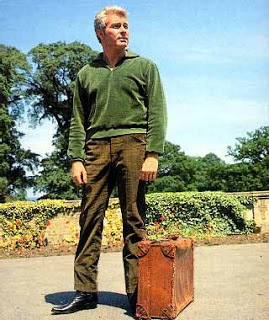 For thirty episodes airing between September 1967 and April 1968, John Mac McGill as portrayed by rough edged actor Richard Bradford, was a downbeat ex-spy turned reluctant private eye. Based in London, he roamed across Europe taking freelance investigations and espionage jobs for $500 a day plus expenses. Always traveling light—his eponymous suitcase containing his little more than his clothes and his gun—he constantly and purposely makes himself a torn in the side of the British authorities, the Soviets, and his old colleagues in American espionage.
For thirty episodes airing between September 1967 and April 1968, John Mac McGill as portrayed by rough edged actor Richard Bradford, was a downbeat ex-spy turned reluctant private eye. Based in London, he roamed across Europe taking freelance investigations and espionage jobs for $500 a day plus expenses. Always traveling light—his eponymous suitcase containing his little more than his clothes and his gun—he constantly and purposely makes himself a torn in the side of the British authorities, the Soviets, and his old colleagues in American espionage.  McGill is an ex-American intelligence agent. Falsely accused of treason, he has been callously frozen out of the intelligence community and turned into a scapegoat—an easy target of retribution for the sins of others. He is a man without a home, without a country. Harassed by deadly enemies, he desperately wants to restore his reputation, but there is a major stumbling block—any serious attempt to clear his name will result in a double agent colleague being tortured or killed in the Soviet Union. This situation becomes an interesting conundrum leading to stories with more of an original twist than the average action show produced by ITC.
McGill is an ex-American intelligence agent. Falsely accused of treason, he has been callously frozen out of the intelligence community and turned into a scapegoat—an easy target of retribution for the sins of others. He is a man without a home, without a country. Harassed by deadly enemies, he desperately wants to restore his reputation, but there is a major stumbling block—any serious attempt to clear his name will result in a double agent colleague being tortured or killed in the Soviet Union. This situation becomes an interesting conundrum leading to stories with more of an original twist than the average action show produced by ITC.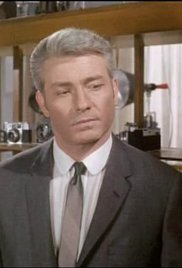 A method actor, Richard Bradford played the chain smoking, hard drinking, constantly beaten up McGill with a tough, but laconic ease with Brando-esque inflections—especially in his tendency to mumble dialogue. When asked at a casting meeting how tall he was, Bradford replied, How tall do you have to be? With a chiseled jaw, cat-like body language, and broad shoulders, he was the perfect actor with the perfect manner to portray the character.
A method actor, Richard Bradford played the chain smoking, hard drinking, constantly beaten up McGill with a tough, but laconic ease with Brando-esque inflections—especially in his tendency to mumble dialogue. When asked at a casting meeting how tall he was, Bradford replied, How tall do you have to be? With a chiseled jaw, cat-like body language, and broad shoulders, he was the perfect actor with the perfect manner to portray the character.The opposite of Danger Man/Secret Agent John Drake, McGill is an antihero, but not without scruples. He is prone to violence both delivered and received—fisticuffs, guns blazing, and blood flowing were common place. But while less sympathetic than Danger Man, Man In A Suitcase combined brute action and subtle humor in a distinctive, watchable style.
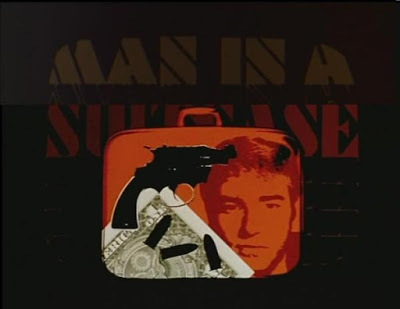 Created by Richard Harris and Dennis Spooner (The Avengers), the show was filmed in and around Pinewood Studios. It also did plenty of location shooting in London, which not only represented itself, but stood in for many other corners of Europe. However faked European backgrounds were, they were cleverly filmed and believable, never a distraction. McGill once landed in the village of Port Merion, Wales, where The Prisoner was film, which was filling in at the time for a corner of Italy.
Created by Richard Harris and Dennis Spooner (The Avengers), the show was filmed in and around Pinewood Studios. It also did plenty of location shooting in London, which not only represented itself, but stood in for many other corners of Europe. However faked European backgrounds were, they were cleverly filmed and believable, never a distraction. McGill once landed in the village of Port Merion, Wales, where The Prisoner was film, which was filling in at the time for a corner of Italy. 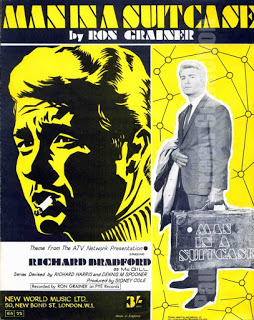 In another nod to The Prisoner, one of McGill’s many lady friends tips her fingers to him in a mock salute and says, be seeing you, as he leaves her apartment. This, of course, was the gesture and catchphrase made famous in The Prisoner. To top things of, the theme and incidental music for Man in a Suitcase was composed and conducted by Rob Grainer, who also created the music for The Prisoner.
In another nod to The Prisoner, one of McGill’s many lady friends tips her fingers to him in a mock salute and says, be seeing you, as he leaves her apartment. This, of course, was the gesture and catchphrase made famous in The Prisoner. To top things of, the theme and incidental music for Man in a Suitcase was composed and conducted by Rob Grainer, who also created the music for The Prisoner.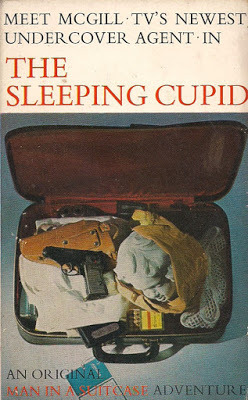
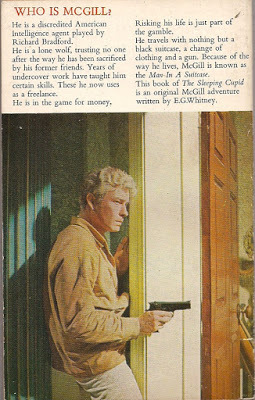 There was a Man In A Suitcase tie-in novel published in 1967. The Sleeping Cupid was a surprisingly good original story written by E.G. Whitney, a pseudonym for thriller writer Ben Healey. Though British, he does a credible job with McGill’s American vernacular and attitude, with few linguistic tells. The book was published only in the U.K. strangely enough by Daily Mirror Newspapers. As this is arguably the only paperback novel released under this imprint, it may have been a test run for a line of books destined for newsagents only (as opposed to bookstores). This item is rare, but with a bit of patience, it can be found for a reasonable price. It is definetly worth the effort.
There was a Man In A Suitcase tie-in novel published in 1967. The Sleeping Cupid was a surprisingly good original story written by E.G. Whitney, a pseudonym for thriller writer Ben Healey. Though British, he does a credible job with McGill’s American vernacular and attitude, with few linguistic tells. The book was published only in the U.K. strangely enough by Daily Mirror Newspapers. As this is arguably the only paperback novel released under this imprint, it may have been a test run for a line of books destined for newsagents only (as opposed to bookstores). This item is rare, but with a bit of patience, it can be found for a reasonable price. It is definetly worth the effort.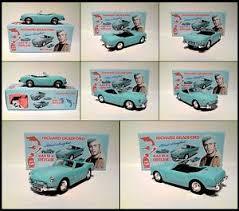 What is even more rare and far from reasonably priced is a 1.43 scale die-cast Code 3 Man In A Suitcase blue Triumph Spitfire MK2. This is a replica of the car McGill drove in the episode Variations, with detail down to the same number. It has a Man In A Suitcase display box with graphic artwork from the series and Richard Bradford's autograph printed on two sides. If this item ever pops up on e-Bay or elsewhere expect to pay $200 to $500.
What is even more rare and far from reasonably priced is a 1.43 scale die-cast Code 3 Man In A Suitcase blue Triumph Spitfire MK2. This is a replica of the car McGill drove in the episode Variations, with detail down to the same number. It has a Man In A Suitcase display box with graphic artwork from the series and Richard Bradford's autograph printed on two sides. If this item ever pops up on e-Bay or elsewhere expect to pay $200 to $500.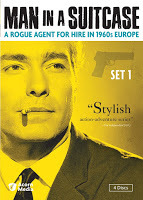
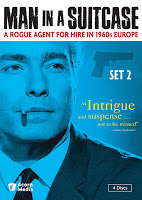
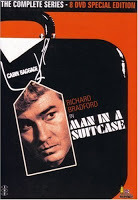 The complete series of Man In A Suitcase can be obtained in DVD in several formats. All episode in one set can be purchase in a U.K. region 2 (non-US) set, or the episodes have been split into two sets for the US DVD market. The resolution is excellent as the discs have been transferred directly from the original prints. There are also many extras, including trailers, foreign titles, bumpers, behind-the-scene stills, a Richard Bradford interview, and a full-color booklet. Unfortunately, forty years later Bradford is a pale imitation of his athletic character. Excellent viewing...
The complete series of Man In A Suitcase can be obtained in DVD in several formats. All episode in one set can be purchase in a U.K. region 2 (non-US) set, or the episodes have been split into two sets for the US DVD market. The resolution is excellent as the discs have been transferred directly from the original prints. There are also many extras, including trailers, foreign titles, bumpers, behind-the-scene stills, a Richard Bradford interview, and a full-color booklet. Unfortunately, forty years later Bradford is a pale imitation of his athletic character. Excellent viewing...NEXT UP: THE BARON
Published on June 20, 2017 19:43
June 18, 2017
BRIT SPY—THE SANDBAGGERS
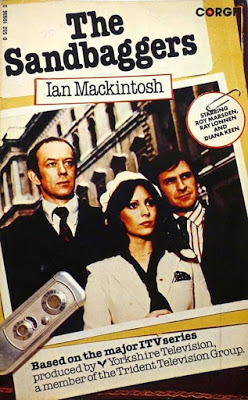
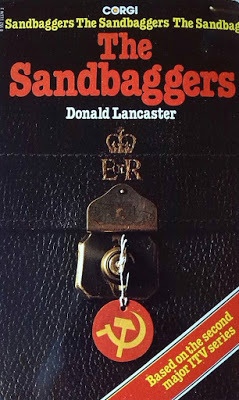 BRIT SPY—THE SANDBAGGERS
BRIT SPY—THE SANDBAGGERSPremiering a decade after the quintessential ‘60s British espionage series Callan—written about in a previous column—The Sandbaggersset the standard for British TV spies in the late ‘70s. Created by Ian Mackintosh, it starred Roy Marsden as spy master Neil Burnside. This was long before Marsden became indelibly linked to his portrayal of detective Adam Dalgliesh, created by P. D. James.
Running from 1978 to 1980, The Sandbaggers was grounded in the reality, the scut work, and the day to day grind of the espionage game and those who choose, willingly or not, to play it. There were no gadgets, no megalomaniacal malefactors bent on world domination, no henchmen with shark teeth or deadly bowler hats, no villains’ lairs hidden in volcanos, underseas, or outer space, and only one explosion in the entire series—which took place in the first episode. Somehow, however, this world of whispers, glances, and devious maneuvering becomes riveting, breath holding, must see DVD TV.
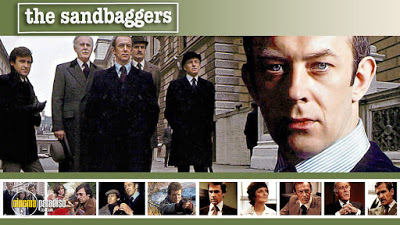 Series creator Ian Mackintosh, was a lifelong naval officer who was possibly involved in espionage during his career—more on this point later. In developing The Sandbaggers, he wanted to get as close to the real world of espionage as possible. To this end, he employed his own specialized knowledge of the UK espionage nexus and the modus operandi of the various branches. This effort at getting close to the truth caused great authoritarian concern. Fearing the show would reveal actual Crown secrets, the government required every episode to be reviewed and given a security clearance before being produced. One episode was axed and never filmed because it was judged to infringe on the Official Secrets Act.
Series creator Ian Mackintosh, was a lifelong naval officer who was possibly involved in espionage during his career—more on this point later. In developing The Sandbaggers, he wanted to get as close to the real world of espionage as possible. To this end, he employed his own specialized knowledge of the UK espionage nexus and the modus operandi of the various branches. This effort at getting close to the truth caused great authoritarian concern. Fearing the show would reveal actual Crown secrets, the government required every episode to be reviewed and given a security clearance before being produced. One episode was axed and never filmed because it was judged to infringe on the Official Secrets Act.The lynchpin of The Sandbaggers is taciturn Neil Burnside, Deputy Director of Operations of the UK Special Intelligence Service (SIS). His most closely guarded resource is his Special Operations Section, known as Sandbaggers—a term used to define those who deceive others about their real intentions or abilities for gain.
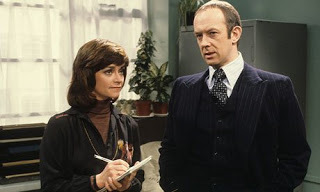 Burnside is on a constant slow burn—calm on the outside, raging on the inside. He is smart, obsessed with his work, passionate about protecting his unit, and willing to do anything—no matter how dirty—to get his job done. Constantly in trouble with his superiors, he is a ruthless adversary, and not a man to cross unless you want your career, your freedom—or possibly your life—to end.
Burnside is on a constant slow burn—calm on the outside, raging on the inside. He is smart, obsessed with his work, passionate about protecting his unit, and willing to do anything—no matter how dirty—to get his job done. Constantly in trouble with his superiors, he is a ruthless adversary, and not a man to cross unless you want your career, your freedom—or possibly your life—to end.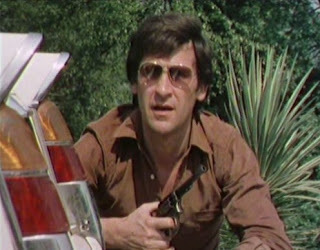 While Sandbaggers #2 and #3 are often killed and replaced, Sandbagger #1—Willy Caine—is a survivor despite, or maybe because of, his aversion to questionable undertakings and his phobia toward guns. Jeff Ross is the head of the CIA in London, who is Burnside’s ally and secret weapon. Diane Lawyer runs the Sandbaggers’ logistics. Her wry and dry sense of humor adds balance to the otherwise grimly austere tone of the show.
While Sandbaggers #2 and #3 are often killed and replaced, Sandbagger #1—Willy Caine—is a survivor despite, or maybe because of, his aversion to questionable undertakings and his phobia toward guns. Jeff Ross is the head of the CIA in London, who is Burnside’s ally and secret weapon. Diane Lawyer runs the Sandbaggers’ logistics. Her wry and dry sense of humor adds balance to the otherwise grimly austere tone of the show. 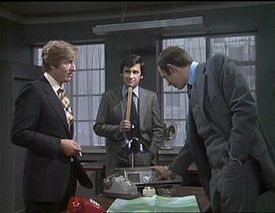 Burnside’s duties most often confine him to seedy, interchangeable, government offices. His immediate adversaries are not those of a foreign power, but petty British government officials—with more power than sense—who argued constantly about how to handle every given situation. The majority of the interference comes from the Director of SIS known as only as C. Next in order of aggravation is Burnside’s counterpart, Deputy Director Matthew Peele, a man who deeply mistrusts Burnside. And finally there is Burnside’s ex-father-in-law, Sir Geoffrey Willingham, a sometimes ally sometimes foe, who is the Permanent Undersecretary of State. To these men who opposed Burnside, agents in the field are a commodity to be used as bargaining chips and sacrificed as often as pawns on a chessboard.
Burnside’s duties most often confine him to seedy, interchangeable, government offices. His immediate adversaries are not those of a foreign power, but petty British government officials—with more power than sense—who argued constantly about how to handle every given situation. The majority of the interference comes from the Director of SIS known as only as C. Next in order of aggravation is Burnside’s counterpart, Deputy Director Matthew Peele, a man who deeply mistrusts Burnside. And finally there is Burnside’s ex-father-in-law, Sir Geoffrey Willingham, a sometimes ally sometimes foe, who is the Permanent Undersecretary of State. To these men who opposed Burnside, agents in the field are a commodity to be used as bargaining chips and sacrificed as often as pawns on a chessboard.  Constantly fighting for people and resources, Burnside is never able to field more than three Sandbaggers—less if one is killed on assignment. As a result, there are too many complex missions and too few Sandbaggers to minimize risks. Burnside is constantly weighing those risks against possible rewards. Often, he is compelled to make the dark choice of putting the sovereignty of the British government above the life of his agents.
Constantly fighting for people and resources, Burnside is never able to field more than three Sandbaggers—less if one is killed on assignment. As a result, there are too many complex missions and too few Sandbaggers to minimize risks. Burnside is constantly weighing those risks against possible rewards. Often, he is compelled to make the dark choice of putting the sovereignty of the British government above the life of his agents.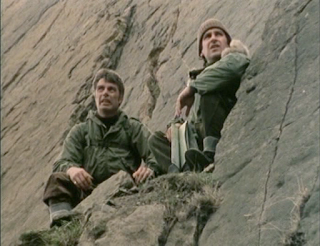 The scenarios confronting The Sandbaggers are frequently ambiguous. There is never enough data, evidence, or time for Burnside to make informed life-or-death decisions. Instead, missions are run based on innuendo, rumors, and half-truths—situational guesses. Plans and strategies are heatedly discussed by government toadies jockeying for political favor and position. Miscommunication, and sometimes downright disinformation, is rampant. Bad luck and deadly coincidences abound. The screws on Burnside are constantly tightened, sometimes viciously twisted. Everyone, including allies, have hidden agendas.
The scenarios confronting The Sandbaggers are frequently ambiguous. There is never enough data, evidence, or time for Burnside to make informed life-or-death decisions. Instead, missions are run based on innuendo, rumors, and half-truths—situational guesses. Plans and strategies are heatedly discussed by government toadies jockeying for political favor and position. Miscommunication, and sometimes downright disinformation, is rampant. Bad luck and deadly coincidences abound. The screws on Burnside are constantly tightened, sometimes viciously twisted. Everyone, including allies, have hidden agendas. 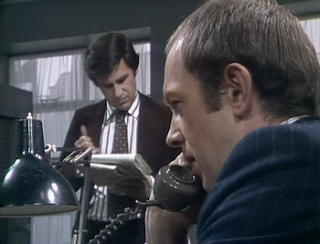 Broadcast at the height of the Cold War, The Sandbaggers played into the public fears of communism and foreign powers. Real countries and stories ripped from fearmongering headlines drove the storylines, the accompanying high stakes and intense urgency of unfolding history palpably riveting. The Sandbaggers don’t always win. Agents die, information is leaked, situations might not be what they appear—all of which can cause missions to go dramatically tits up, with caustic fallout and more finger pointing than a proctologist convention.
Broadcast at the height of the Cold War, The Sandbaggers played into the public fears of communism and foreign powers. Real countries and stories ripped from fearmongering headlines drove the storylines, the accompanying high stakes and intense urgency of unfolding history palpably riveting. The Sandbaggers don’t always win. Agents die, information is leaked, situations might not be what they appear—all of which can cause missions to go dramatically tits up, with caustic fallout and more finger pointing than a proctologist convention.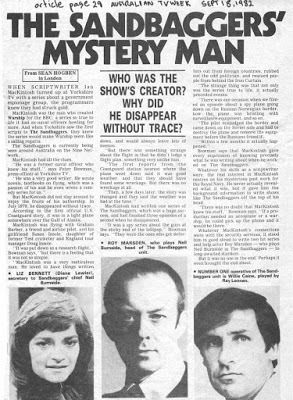 In July 1979, halfway through the writing of the third season of The Sandbaggers, creator and head writer Ian Mackintosh disappeared under mysterious and conspiracy theory riddled circumstances. A light aircraft carrying Mackintosh, Susan Insole (Mackintosh’s girlfriend), and pilot Graham Barber vanished over the Gulf of Alaska.
In July 1979, halfway through the writing of the third season of The Sandbaggers, creator and head writer Ian Mackintosh disappeared under mysterious and conspiracy theory riddled circumstances. A light aircraft carrying Mackintosh, Susan Insole (Mackintosh’s girlfriend), and pilot Graham Barber vanished over the Gulf of Alaska. There was a distress signal sent, but no survivors or wreckage were ever found. The mystery is further complicated by two factors: Barber failed to file a flight plan, and the plane made an unexplained stop at a disused World War II airfield.
Mackintosh left behind four completed scripts for The Sandbaggers, including the finale. Other writers were brought in to round out the full season of episodes, but the magic of The Sandbaggers resided in Mackintosh—who had written all the episodes of the first two seasons. In a story as complicated and ambiguous as the show itself, The Sandbaggers was cancelled.
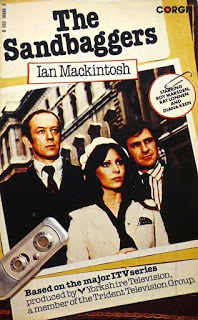 Robert G. Folsom's 2012 biography, The Life and Mysterious Death of Ian MacKintosh, delves deeply into the circumstances of Mackintosh’s death, his naval career (for which he was awarded an MBE), and his success as a television writer.
Robert G. Folsom's 2012 biography, The Life and Mysterious Death of Ian MacKintosh, delves deeply into the circumstances of Mackintosh’s death, his naval career (for which he was awarded an MBE), and his success as a television writer. Two TV tie-ins to The Sandbaggers were published in paperback by Corgi. The first was written by Ian Mackintosh, novelizing two of his scripts from the show’s first season, and published in 1978.
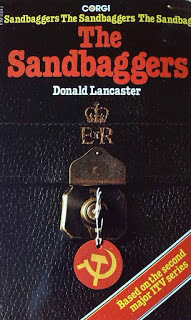 The second tie-in novel is much more rare. Published in 1980, The Sandbaggers: Think of a Number is an original novel written by Donald Lancaster—a pseudonym for Australian mystery novelist William Marshall, best known for his Yellow Thread Street mystery series. In the wake of Mackintosh’s disappearance (and to take cynical advantage of the accompanying headlines), Marshall was given ten days by the publisher to turn in the manuscript. Given the time constraint, and the fact he was working off a binge viewing (way before it became common place) of the first season of The Sandbaggers, Marshal created in a remarkably good story.
The second tie-in novel is much more rare. Published in 1980, The Sandbaggers: Think of a Number is an original novel written by Donald Lancaster—a pseudonym for Australian mystery novelist William Marshall, best known for his Yellow Thread Street mystery series. In the wake of Mackintosh’s disappearance (and to take cynical advantage of the accompanying headlines), Marshall was given ten days by the publisher to turn in the manuscript. Given the time constraint, and the fact he was working off a binge viewing (way before it became common place) of the first season of The Sandbaggers, Marshal created in a remarkably good story.Today, The Sandbaggersdeservedly remains one of the best espionage shows ever written. The three seasons of the show are available individually or in a DVD boxed set, and the tie-in novels can be tracked down with minor effort.
NEXT UP: MAN IN A SUITCASE...
Published on June 18, 2017 19:59
June 15, 2017
BRIT SPY—CALLAN
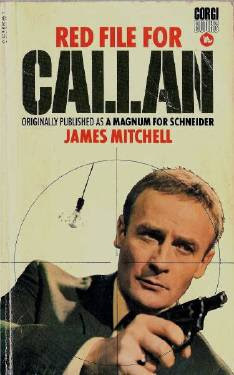 BRIT SPY—CALLAN
BRIT SPY—CALLAN In the late ‘60s, The Man From U.N.C.L.E., Mission Impossible, I Spy, and The Wild Wild West, among many others, were riding the crest of the James Bond superspy explosion on American television. Across the pond, spies were also dominating the broadcast channels. Entertainment espionage, however, was very different on either side of the Atlantic.
While 007 was most definitely the quintessential British spy, it was the American spy shows that followed his lead more closely. On American TV, espionage was fun—cool gadgets, maniacal villains with henchmen and hidden lairs, beautiful women, and suave, karate chopping, heroes with blindingly white teeth.
On the other side of the pond things were different. In British spy shows, espionage was business—a deadly business. Gritty, harsh, morally ambiguous, dour, and most of all, cynical, British TV spies in the ‘60s were the antithesis of Bond. It was as if Bond was a drunken relative at a party—entertaining, but embarrassing—and much must be done to regain a stiff upper lip façade.
Over the next few columns, I plan to look at the best of the British television spies and the tie-in novels connected to them.
*******
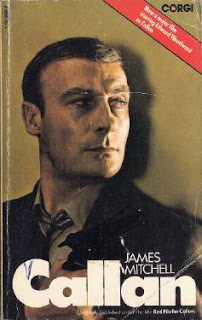 First up is the quintessential British spy series, Callan.
First up is the quintessential British spy series, Callan.In the 1967 British television drama A Magnum for Schneider, the terse talking, totally pitiless secret agent David Callan became an instant touchstone of British espionage. A hugely successful television series quickly followed—running from 1967 to 1972.
Callan works for a shadowy governmental agency known as the Section, which deals with internal security threats to the United Kingdom. Using it’s carte blanche mandate, the Section is ruthless in its methods. Torture is the preferred method of interrogation, and targets sanctioned for possible assassination are so routine they come in color coded files. If the file is red, the individual inside will soon be dead. No espionage agency connected to the Western world (the supposed good guys) has ever been portrayed in such a sinister manner. Executioner, bodyguard, stone killer, Callan is a blunt instrument wielded by Hunter, his always despised and eventually hated agency control.
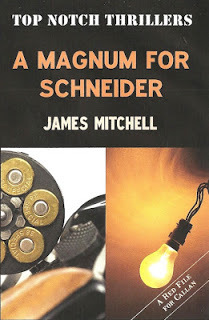 Created by author James Mitchell, and portrayed with callous world-weariness by actor Edward Woodward, Callan became an iconic anti-Bond—a man doing a blue collar job he often regrets, but keeps doing because it is the only thing he knows how to do—and he’s very, very good at it. It says something when a coldly calculating human stiletto is seen as a hero because he is the least morally ambiguous character in the series.
Created by author James Mitchell, and portrayed with callous world-weariness by actor Edward Woodward, Callan became an iconic anti-Bond—a man doing a blue collar job he often regrets, but keeps doing because it is the only thing he knows how to do—and he’s very, very good at it. It says something when a coldly calculating human stiletto is seen as a hero because he is the least morally ambiguous character in the series. Callan is a man without friends. A malodorous thief, known only as Lonely, is his only acquaintance—a man whom he constantly threatens and abuses. Theirs is a classic love hate relationship maintained by fear, cash, blackmail, and mutual need. Yet there remains a tight bond between the two men. They may hate each other, but they hate others more. They are two islands connected by a frayed and splintered wooden rope bridge.
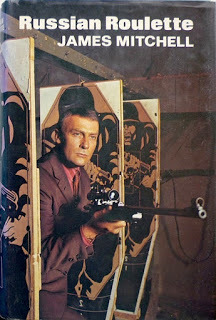 Before he began to write extensively for television, Callan creator James Mitchell started his writing career as a novelist. In the ‘60s, after several novels written under different pen names, Mitchell began a successful series of espionage novels featuring gunrunner-turned-secret agent John Craig, which he wrote using the pseudonym James Munro.
Before he began to write extensively for television, Callan creator James Mitchell started his writing career as a novelist. In the ‘60s, after several novels written under different pen names, Mitchell began a successful series of espionage novels featuring gunrunner-turned-secret agent John Craig, which he wrote using the pseudonym James Munro. When Callan became a British television sensation, it was a natural segue for Mitchell to write a series of books based on the character. Published under his own name, Mitchell based the first novel, A Magnum For Schneider—aka: A Red File For Callanin the USA, and later simply Callanwhen it was reissued to tie-in with the Callanmovie release—on the original television drama. Callan is washed up. The most efficient killer in Europe is working as a book-keeper for a small, dusty merchant. But circumstances force his old boss Hunter to employ him for one last operation—eliminate a man named Schneider. A cheerful, friendly, affluent man, Schneider and Callan have a shared passion for model soldiers used in battle recreations. The operation is studded with lethal booby-traps, but Callan's own inhibitions become the most dangerous.
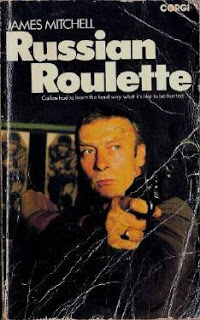 By the time the second Callen novel, Russian Roulette, was originally published the Callan TV series had effectively ended. However, the character continued to have a strong following.
By the time the second Callen novel, Russian Roulette, was originally published the Callan TV series had effectively ended. However, the character continued to have a strong following. Russian Roulette is an original novel, not tied to any television episode. It recognizes Callan for what he is—the best killer the British have ever had. His skills are inherent in his survival instincts, his stalking animal patience, and his ability to destroy without hesitation.
The KGB want Callan badly enough to ante up the top British spy held captive in the Kremlin in exchange for his corpse. The British agree. Abandoned and alone in the alleys, squares, and parks of London, unarmed and half-blind, Callan becomes fair prey for three deadly Russian KGB agents with a grudge. But Callan is still the best killer the British have, and even without a gun, he is a walking bloody arsenal.
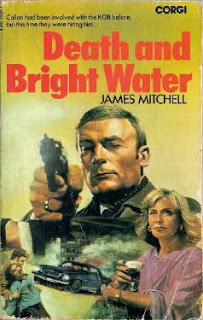 In Death And Bright Water, Callan finds retirement is not easy for a man of his background. He believes his days with the Section are over. He'd had enough and walked away. But a man like Callan can never escape killing and violence. When the mysterious Dr. Blythe appears with a proposition, Callan can’t refuse. It is a simple kidnapping job—getting the beautiful Sophie Kollonaki's daughter out of Crete. But on the way to the Greek island, Callan and the faithful Lonely begin to suspect Sophie is involved with the KGB—and where the KGB lurk, death is never far away.
In Death And Bright Water, Callan finds retirement is not easy for a man of his background. He believes his days with the Section are over. He'd had enough and walked away. But a man like Callan can never escape killing and violence. When the mysterious Dr. Blythe appears with a proposition, Callan can’t refuse. It is a simple kidnapping job—getting the beautiful Sophie Kollonaki's daughter out of Crete. But on the way to the Greek island, Callan and the faithful Lonely begin to suspect Sophie is involved with the KGB—and where the KGB lurk, death is never far away.S
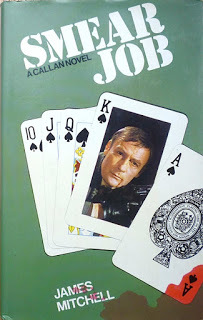 mear Job begins with Hunter needing two little favors from Callan. Stealing a book from a library sounds easy, except the library is in Sicily. But making sure Gunther Lesir loses a fortune at cards is a bit more of a problem, especially as Callan is no card sharp.
mear Job begins with Hunter needing two little favors from Callan. Stealing a book from a library sounds easy, except the library is in Sicily. But making sure Gunther Lesir loses a fortune at cards is a bit more of a problem, especially as Callan is no card sharp. Neither of the favors, however, are as big a problem as Callan’s knowledge of Hunter—there would be something more, something nasty. When the twist comes, Callan finds himself on an excursion to Mexico into the dirtiest businesses in the world—drugs, prostitution, blackmail, and death.
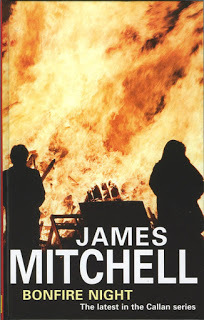 The last Callan novel, Bonfire Night, would not appear until a number of years after Smear Job. The world has changed...Callan is rich, living in luxury in his own personal castle in Spain and in danger of falling in love. His old partner-in-crime, Lonely, is even richer—now a computer genius and businessman going straight (more or less) under the name Roger Bullivant.
The last Callan novel, Bonfire Night, would not appear until a number of years after Smear Job. The world has changed...Callan is rich, living in luxury in his own personal castle in Spain and in danger of falling in love. His old partner-in-crime, Lonely, is even richer—now a computer genius and businessman going straight (more or less) under the name Roger Bullivant. The new Head of Section, codename Hunter, is a woman, but the Section no longer has a hold over Callan. Then Voss, the ex-Stasi sadist who tortured Callan in East Berlin, surfaces long enough to make an attempt on Callan’s life—endangering those to whom Callen has become close. Blood and death follow as Callan rages from London to the south of Spain, ready to bring down his own form of retribution.
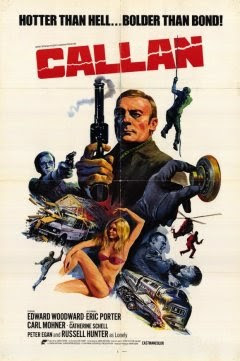 The cult following for Callan, fed by Mitchell’s novels, was strong enough for a 1974 feature film, simply titled Callan, to be produced.
The cult following for Callan, fed by Mitchell’s novels, was strong enough for a 1974 feature film, simply titled Callan, to be produced. Following the same story presented in A Magnum for Schneider, Callan has been forced into retirement after appearing to lose his nerve. However, he is called back into service to handle the assassination of Schneider, a German businessman. His former boss, Hunter, promises Callan he'll be returned to active status if he follows orders—something Callan desperately wants as without the work, he has nothung other than staring into the void. However, as always, Callan refuses to act until he knows why Schneider has been marked for death. Worth watching for Callan completists.
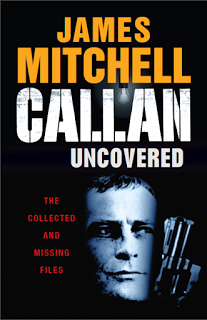
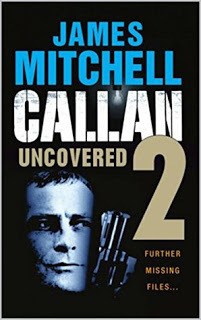 For all Callan fans, however, there remains a special treat. James Mitchell also wrote (at least) forty short stories featuring Callan, Lonely, and the regular members of the Section. These were originally published in Britain’s Sunday Express and syndicated in newspapers in Singapore and Australia.
For all Callan fans, however, there remains a special treat. James Mitchell also wrote (at least) forty short stories featuring Callan, Lonely, and the regular members of the Section. These were originally published in Britain’s Sunday Express and syndicated in newspapers in Singapore and Australia. In 2014, author and Callan expert, Mike Ripley, did a vast amount of research to gather these stories together in two volumes—Callan Uncoveredand Callan Uncovered 2. In my opinion, these collections are not to be missed. Their terse, stripped down, prose match Callan’s personality perfectly. The novels are very good entrées, but for a true taste of Callan, the short stories are a feast.
NEXT UP: THE SANDBAGGERS...
Published on June 15, 2017 14:07
BRIT-SPY—CALLAN
 BRIT-SPY—CALLAN
BRIT-SPY—CALLAN In the late ‘60s, The Man From U.N.C.L.E., Mission Impossible, I Spy, and The Wild Wild West, among many others, were riding the crest of the James Bond superspy explosion on American television. Across the pond, spies were also dominating the broadcast channels. Entertainment espionage, however, was very different on either side of the Atlantic.
While 007 was most definitely the quintessential British spy, it was the American spy shows that followed his lead more closely. On American TV, espionage was fun—cool gadgets, maniacal villains with henchmen and hidden lairs, beautiful women, and suave, karate chopping, heroes with blindingly white teeth.
In Britain things were different. In British spy shows, espionage was business—a deadly business. Gritty, harsh, morally ambiguous, dour and, most of all, cynical, spies on British TV in the ‘60s were the antithesis of Bond. It was as if Bond was a drunken relative at a party—entertaining, but embarrassing—and much must be done to regain a stiff upper lip façade.
Over the next few columns, I plan to look at the best of the British television spies and the tie-in novels connected to them.
*******
 First up is the quintessential British spy series, Callan.
First up is the quintessential British spy series, Callan.In the 1967 British television drama A Magnum for Schneider, the terse talking, totally pitiless secret agent David Callan became an instant touchstone of British espionage. A hugely successful television series quickly followed—running from 1967 to 1972.
Callan works for a shadowy governmental agency known as the Section, which deals with internal security threats to the United Kingdom. Using it’s carte blanche mandate, the Section is ruthless in its methods. Torture is the preferred method of interrogation, and targets sanctioned for possible assassination are so routine they come in color coded files. If the file is red, the individual inside will soon be dead. No espionage agency connected to the Western world (the supposed good guys) has ever been portrayed in such a sinister manner. Executioner, bodyguard, stone killer, Callan is a blunt instrument wielded by Hunter, his always despised and eventually hated agency control.
 Created by author James Mitchell, and portrayed with callous world-weariness by actor Edward Woodward, Callan became an iconic anti-Bond—a man doing a blue collar job he often regrets, but keeps doing because it is the only thing he knows how to do—and he’s very, very good at it. It says something when a coldly calculating human stiletto is seen as a hero because he is the least morally ambiguous character in the series.
Created by author James Mitchell, and portrayed with callous world-weariness by actor Edward Woodward, Callan became an iconic anti-Bond—a man doing a blue collar job he often regrets, but keeps doing because it is the only thing he knows how to do—and he’s very, very good at it. It says something when a coldly calculating human stiletto is seen as a hero because he is the least morally ambiguous character in the series. Callan is a man without friends. A malodorous thief. known only as Lonely, is his only acquaintance—a man whom he constantly threatens and abuses. Theirs is a classic love hate relationship maintained by fear, cash, blackmail, and mutual need. Yet there remains a tight bond between the two men. They may hate each other, but they hate others more. They are two islands connected by a frayed and splintered wooden rope bridge.
 Before he began to write extensively for television, Callan creator James Mitchel began his writing career as a novelist. In the ‘60s, after several novels written under different pen names, Mitchel began a successful series of espionage novels featuring gunrunner-turned-secret agent John Craig, which he wrote using the pseudonym James Munro.
Before he began to write extensively for television, Callan creator James Mitchel began his writing career as a novelist. In the ‘60s, after several novels written under different pen names, Mitchel began a successful series of espionage novels featuring gunrunner-turned-secret agent John Craig, which he wrote using the pseudonym James Munro. When Callan became a British television sensation, it was a natural segue for Mitchell to write a series of books based on the character. Published under his own name, Mitchell based the first novel, A Magnum For Schneider—aka: A Red File For Callanin the USA, and later simply Callanwhen it was reissued to tie-in with the Callanmovie release—on the original television drama. Callan is washed up. The most efficient killer in Europe is working as a book-keeper for a small, dusty merchant. But circumstances force his old boss Hunter to employ him for one last operation—eliminate a man named Schneider. A cheerful, friendly, affluent man, Schneider and Callan have a shared passion for model soldiers used in battle recreations. The operation is studded with lethal booby-traps, but Callan's own inhibitions become the most dangerous.
 By the time the second Callen novel, Russian Roulette, was originally published the Callan TV series had effectively ended. However, the character continued to have a strong following. Russian Roulette is an original novel, not tied to any television episode. It recognizes Callan for what he is—the best killer the British have ever had. His skills are inherent in his survival instincts, his stalking animal patience, and his ability to destroy without hesitation. The KGB wants Callan badly enough to ante up the top British spy held captive in the Kremlin in exchange for his corpse. The British agree. Abandoned and alone in the alleys, squares, and parks of London, unarmed and half-blind, Callan becomes fair prey for three deadly Russian KGB agents with a grudge. But Callan is still the best killer the British have, and even without a gun, he is a walking bloody arsenal.
By the time the second Callen novel, Russian Roulette, was originally published the Callan TV series had effectively ended. However, the character continued to have a strong following. Russian Roulette is an original novel, not tied to any television episode. It recognizes Callan for what he is—the best killer the British have ever had. His skills are inherent in his survival instincts, his stalking animal patience, and his ability to destroy without hesitation. The KGB wants Callan badly enough to ante up the top British spy held captive in the Kremlin in exchange for his corpse. The British agree. Abandoned and alone in the alleys, squares, and parks of London, unarmed and half-blind, Callan becomes fair prey for three deadly Russian KGB agents with a grudge. But Callan is still the best killer the British have, and even without a gun, he is a walking bloody arsenal. In Death And Bright Water, Callan finds retirement is not easy for a man of his background. He believes his days with The Section are over. He'd had enough and walked away. But a man like Callan can never escape killing and violence. When the mysterious Dr. Blythe appears with a proposition, Callan can’t refuse. It is a simple kidnapping job—getting the beautiful Sophie Kollonaki's daughter out of Crete. But on the way to the Greek island, Callan and the faithful Lonely begin to suspect Sophie is involved with the KGB—and where the KGB lurk, death is never far away.
In Death And Bright Water, Callan finds retirement is not easy for a man of his background. He believes his days with The Section are over. He'd had enough and walked away. But a man like Callan can never escape killing and violence. When the mysterious Dr. Blythe appears with a proposition, Callan can’t refuse. It is a simple kidnapping job—getting the beautiful Sophie Kollonaki's daughter out of Crete. But on the way to the Greek island, Callan and the faithful Lonely begin to suspect Sophie is involved with the KGB—and where the KGB lurk, death is never far away.S
 mear Job begins with Hunter needing two little favors from Callan. Stealing a book from a library sounds easy, except the library is in Sicily. But making sure Gunther Lesir loses a fortune at cards is a bit more of a problem, especially as Callan is no card sharp. Neither of the favors, however, are as big a problem as Callan’s knowledge of Hunter—there would be something more, something nasty. When the twist comes, Callan finds himself on an excursion to Mexico into the dirtiest businesses in the world—drugs, prostitution, blackmail, and death.
mear Job begins with Hunter needing two little favors from Callan. Stealing a book from a library sounds easy, except the library is in Sicily. But making sure Gunther Lesir loses a fortune at cards is a bit more of a problem, especially as Callan is no card sharp. Neither of the favors, however, are as big a problem as Callan’s knowledge of Hunter—there would be something more, something nasty. When the twist comes, Callan finds himself on an excursion to Mexico into the dirtiest businesses in the world—drugs, prostitution, blackmail, and death. The last Callan novel, Bonfire Night, would not appear until a number of years after Smear Job. The world has changed...Callan is rich, living in luxury in his own personal castle in Spain and in danger of falling in love. His old partner-in-crime, Lonely, is even richer—now a computer genius and businessman going straight (more or less) under the name Roger Bullivant. The new Head of Section, codename Hunter, is a woman, but the Section no longer has a hold over Callan. Then Voss, the ex-Stasi sadist who tortured Callan in East Berlin, surfaces long enough to make an attempt on Callan’s life and endangers those to whom Callen has become close. Blood and death follow as Callan rages from London to the south of Spain, ready to bring down his own form of retribution.
The last Callan novel, Bonfire Night, would not appear until a number of years after Smear Job. The world has changed...Callan is rich, living in luxury in his own personal castle in Spain and in danger of falling in love. His old partner-in-crime, Lonely, is even richer—now a computer genius and businessman going straight (more or less) under the name Roger Bullivant. The new Head of Section, codename Hunter, is a woman, but the Section no longer has a hold over Callan. Then Voss, the ex-Stasi sadist who tortured Callan in East Berlin, surfaces long enough to make an attempt on Callan’s life and endangers those to whom Callen has become close. Blood and death follow as Callan rages from London to the south of Spain, ready to bring down his own form of retribution. The cult following for Callan, fed by Mitchell’s novels, was strong enough for a 1974 feature film, simply titled Callan, to be produced. Following the same story presented in A Magnum for Schneider, Callan has been forced into retirement after appearing to lose his nerve. However, he is called back into service to handle the assassination of Schneider, a German businessman. His former boss, Hunter, promises Callan he'll be returned to active status if he follows orders—something Callan desperately wants as without the work he is looking directly into the void. However, as always, Callan refuses to act until he knows why Schneider has been marked for death. Worth watching for Callan completists.
The cult following for Callan, fed by Mitchell’s novels, was strong enough for a 1974 feature film, simply titled Callan, to be produced. Following the same story presented in A Magnum for Schneider, Callan has been forced into retirement after appearing to lose his nerve. However, he is called back into service to handle the assassination of Schneider, a German businessman. His former boss, Hunter, promises Callan he'll be returned to active status if he follows orders—something Callan desperately wants as without the work he is looking directly into the void. However, as always, Callan refuses to act until he knows why Schneider has been marked for death. Worth watching for Callan completists. 
 For all Callan fans, however, there remains a special treat. James Mitchell also wrote (at least) forty short stories featuring Callan, Lonely, and the regular members of The Section. These were originally published in Britain’s Sunday Express and syndicated in newspapers in Singapore and Australia. In 2014, author and Callan expert, Mike Ripley, did a vast amount of research to gather these stories together in two volumes—Callan Uncoveredand Callan Uncovered 2. In my opinion, these collections are not to be missed. Their terse, stripped down, prose match Callan’s personality perfectly. The novels are very good entrées, but for a true taste of Callan, the short stories are a feast.
For all Callan fans, however, there remains a special treat. James Mitchell also wrote (at least) forty short stories featuring Callan, Lonely, and the regular members of The Section. These were originally published in Britain’s Sunday Express and syndicated in newspapers in Singapore and Australia. In 2014, author and Callan expert, Mike Ripley, did a vast amount of research to gather these stories together in two volumes—Callan Uncoveredand Callan Uncovered 2. In my opinion, these collections are not to be missed. Their terse, stripped down, prose match Callan’s personality perfectly. The novels are very good entrées, but for a true taste of Callan, the short stories are a feast.NEXT UP: THE SANDBAGGERS...
Published on June 15, 2017 14:07
June 2, 2017
SIX-GUN JUSTICE
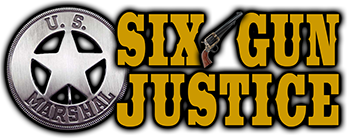 ( THE WESTERN GENRE IN BOOKS, FILMS, AND ON TV )
( THE WESTERN GENRE IN BOOKS, FILMS, AND ON TV ) Full of six-gun blazing action, the western is an enduring American genre. This lecture and discussion ( led by author and genre expert Paul Bishop ) will explore the saga and books of western authors from the pulp fiction of Louis L’Amour to Elmore Leonard and other legendary and contemporary western authors. Movies from Randolph Scott to John Wayne to Clint Eastwood will also be discussed, along with western TV series from their heyday in the 60s AND 70s.
( PRESENTED BY )
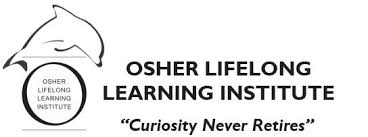 ( IN COOPERATION WITH )
( IN COOPERATION WITH )

( FOR STUDENTS OVER 50 )
FOR INFO AND REGISTRATION CLICK HERE OR CALL( 805-437-2748 )
THE BELOW DATES WILL BE TWO-HOUR ( TASTE OF OLLI )LECTURESin preparation
for a FOUR WEEK
mini-class
SCHEDULED FOR
THE FALL SEMESTER)TUESDAY, JUNE 27 1PM to 3PM)THURSDAY, JULY 27 1PM to 3PM
Published on June 02, 2017 14:38
May 29, 2017
WANDERING DOWN THE RABBIT HOLE
 WANDERING DOWN THE RABBIT HOLE BLOGS, WHITTINGTON, ELVIS,NOVELIZATIONS, COVERS, AND CHARRO! I must apologize upfront. This post started out to be an examination of the brilliant cover for the Gold Medal original paperback publication of Charro! by Harry Whittington, but a rabbit hole appeared and I disappeared down it on what has become a quest of dubious proportions. It all started with a six-hundred word entry I was composing about Whittington’s novel (more on this later) Charro! for an upcoming entertainment book, 52 Weeks 52 Westerns, which I am co-authoring with my partner on the project, Scott Harris. Six-hundred strictly rationed words does not go very far. There were some unusual aspects of the paperback cover for Charro! I wanted to explore, but no space to do it. I kept the entry under the proscribed word count by promising myself I would give the cover six-hundred words of its own in a separate and expanded blog post...
WANDERING DOWN THE RABBIT HOLE BLOGS, WHITTINGTON, ELVIS,NOVELIZATIONS, COVERS, AND CHARRO! I must apologize upfront. This post started out to be an examination of the brilliant cover for the Gold Medal original paperback publication of Charro! by Harry Whittington, but a rabbit hole appeared and I disappeared down it on what has become a quest of dubious proportions. It all started with a six-hundred word entry I was composing about Whittington’s novel (more on this later) Charro! for an upcoming entertainment book, 52 Weeks 52 Westerns, which I am co-authoring with my partner on the project, Scott Harris. Six-hundred strictly rationed words does not go very far. There were some unusual aspects of the paperback cover for Charro! I wanted to explore, but no space to do it. I kept the entry under the proscribed word count by promising myself I would give the cover six-hundred words of its own in a separate and expanded blog post...
 Then I fell down the rabbit hole...In researching details of the cover, I came across further interesting (at least to me) information on the novel itself, the movie, and the novel’s author Harry Whittington. Six-hundred words turned into eight-hundred, then a thousand—and still my fingers were flashing across the keyboard. I even had to stop long enough to return to the top of what was now an article, and add the one-hundred, then two-hundred, then more words constituting this introduction. Talk about losing control of the process... BLOGS The general consensus in our age of limited attention spans, is nobody will read a blog post over six-hundred words—maybe eight-hundred if they are really (really, really) interested. Anything longer—oh, look, shiny! I also regularly hear nobody reads blogs anymore. If you can’t say something in an Internet word-bite—basically a bumper-stickers’ worth of organized letters scrolling up a newsfeed—you might as well not bother.
Then I fell down the rabbit hole...In researching details of the cover, I came across further interesting (at least to me) information on the novel itself, the movie, and the novel’s author Harry Whittington. Six-hundred words turned into eight-hundred, then a thousand—and still my fingers were flashing across the keyboard. I even had to stop long enough to return to the top of what was now an article, and add the one-hundred, then two-hundred, then more words constituting this introduction. Talk about losing control of the process... BLOGS The general consensus in our age of limited attention spans, is nobody will read a blog post over six-hundred words—maybe eight-hundred if they are really (really, really) interested. Anything longer—oh, look, shiny! I also regularly hear nobody reads blogs anymore. If you can’t say something in an Internet word-bite—basically a bumper-stickers’ worth of organized letters scrolling up a newsfeed—you might as well not bother.
 These contemporary edicts are exactly why I have a blog—so I can write about anything at any length. It doesn’t matter if a post is so long it can’t be experienced without the reader’s lips getting tired. It doesn’t matter if the obscure subject matter can’t distract a magpie from a gleaming pop-top (does anyone still know what those are?). It doesn’t even matter if I ramble down rabbit holes or create metaphors of vague provenance—it’s my blog...A place where those who understand and share the oddities of my enthusiasms are willing to engage by staying the course and sharing their own thoughts in return. My point? Oh, yeah...I’m supposed to be getting to the point...Here’s a whole bunch of self-indulgent words about minutia related to Charro!—the book, the movie, Elvis, Harry Whittington, cover artist Ron Lesser, and…(you get where this is going). Wander with me down this rabbit hole at your own risk... CHARRO!—HARRY WHITTINGTON There wasn’t a genre of novel Harry Whittington couldn’t write. Known as The King of the Pulps—a title he shared with high adventure writer H. Bedford-Jones—Whittington was incredibly prolific, writing over two hundred novels. On one occasion, he gunned out seven in a single month!
These contemporary edicts are exactly why I have a blog—so I can write about anything at any length. It doesn’t matter if a post is so long it can’t be experienced without the reader’s lips getting tired. It doesn’t matter if the obscure subject matter can’t distract a magpie from a gleaming pop-top (does anyone still know what those are?). It doesn’t even matter if I ramble down rabbit holes or create metaphors of vague provenance—it’s my blog...A place where those who understand and share the oddities of my enthusiasms are willing to engage by staying the course and sharing their own thoughts in return. My point? Oh, yeah...I’m supposed to be getting to the point...Here’s a whole bunch of self-indulgent words about minutia related to Charro!—the book, the movie, Elvis, Harry Whittington, cover artist Ron Lesser, and…(you get where this is going). Wander with me down this rabbit hole at your own risk... CHARRO!—HARRY WHITTINGTON There wasn’t a genre of novel Harry Whittington couldn’t write. Known as The King of the Pulps—a title he shared with high adventure writer H. Bedford-Jones—Whittington was incredibly prolific, writing over two hundred novels. On one occasion, he gunned out seven in a single month!
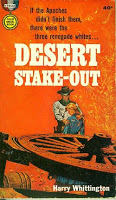
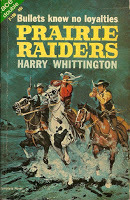
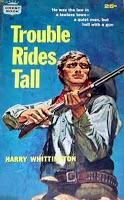 Whittington started his wordslinging career writing westerns, eventually producing thirty-five tales of six-gun justice. However, it was his hardboiled crime fiction for which he became revered.
Whittington started his wordslinging career writing westerns, eventually producing thirty-five tales of six-gun justice. However, it was his hardboiled crime fiction for which he became revered.
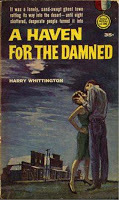
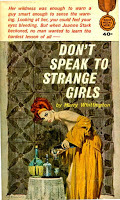
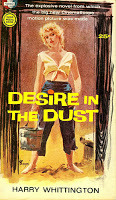 In the 80s, near the end of his career, Whittington returned to the western genre, writing a fistful of entries in the Longarmseries of Adult Westerns. The series, now numbering over 400 entries, was written by numerous authors under the pseudonym Tabor Evans. Whittington’s Longarm titles (Longarm On the Humboldt, Longarm and the Golden Lady, Longarm and the Blue Norther, Longarm in Silver City, Longarm in Boulder Canyon, Longarm in the Big Thicket) are highly sought after by collectors of his work.
In the 80s, near the end of his career, Whittington returned to the western genre, writing a fistful of entries in the Longarmseries of Adult Westerns. The series, now numbering over 400 entries, was written by numerous authors under the pseudonym Tabor Evans. Whittington’s Longarm titles (Longarm On the Humboldt, Longarm and the Golden Lady, Longarm and the Blue Norther, Longarm in Silver City, Longarm in Boulder Canyon, Longarm in the Big Thicket) are highly sought after by collectors of his work.
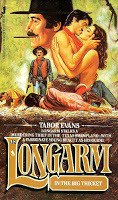
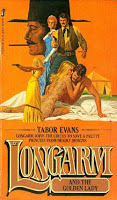
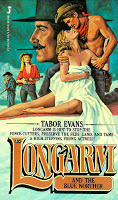
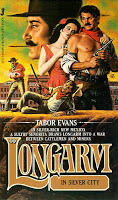
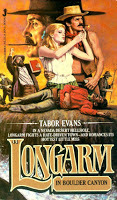
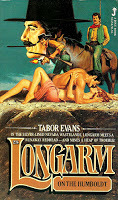 CHARRO!—THE NOVELIZATION
CHARRO!—THE NOVELIZATION
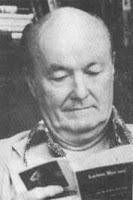 Whittington was also a go-to guy when it came to writing novelizations of movies and television series tie-in novels. Most of these were work for hire—a one-time payment against which the author surrenders all rights to the work, including any future residuals. Work for hire contracts—often written under pseudonyms—were standard for almost all novelizations or TV series tie-in books. They were eating money for many authors while they worked on other mainstream or genre books of their own. Often these types of books sold well, but rarely rose to bestselling levels. However, Whittington wrote the second of Ace Books’ The Man From U.N.C.L.E. paperback original tie-in series, The Doomsday Affair, for which he was paid $1,500 on a work for hire basis. The Man From U.N.C.L.E. series was at the peak of its phenomenal popularity at the time and the book went on to become an international bestseller— placing in the top five paperback best-sellers in the US for 1966, with a whopping ten printings in the first six months. While they were not contractually obligated, Ace Books Ace never paid Whittington anything beyond the initial $1,500.
Whittington was also a go-to guy when it came to writing novelizations of movies and television series tie-in novels. Most of these were work for hire—a one-time payment against which the author surrenders all rights to the work, including any future residuals. Work for hire contracts—often written under pseudonyms—were standard for almost all novelizations or TV series tie-in books. They were eating money for many authors while they worked on other mainstream or genre books of their own. Often these types of books sold well, but rarely rose to bestselling levels. However, Whittington wrote the second of Ace Books’ The Man From U.N.C.L.E. paperback original tie-in series, The Doomsday Affair, for which he was paid $1,500 on a work for hire basis. The Man From U.N.C.L.E. series was at the peak of its phenomenal popularity at the time and the book went on to become an international bestseller— placing in the top five paperback best-sellers in the US for 1966, with a whopping ten printings in the first six months. While they were not contractually obligated, Ace Books Ace never paid Whittington anything beyond the initial $1,500.
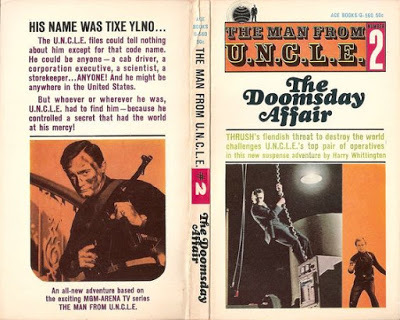
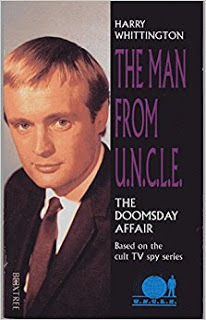
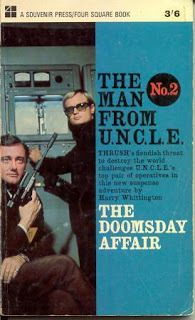 While other writers raced through work for hire novelizations or TV tie-in books, often doing no more than one sloppy draft to get the quick paycheck, Whittington never phoned in his work. As a result, Whittington’s novelizations are always worth reading.
While other writers raced through work for hire novelizations or TV tie-in books, often doing no more than one sloppy draft to get the quick paycheck, Whittington never phoned in his work. As a result, Whittington’s novelizations are always worth reading.
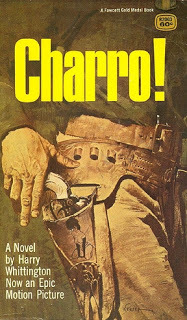 Case in point, Whittington's novelization of the Elvis Presley movie Charro! is among his best work in the Western genre. To take timely advantage of a movie’s initial release, many novelizations are written based only on a brief script outline known as a treatment. As a novelization’s author is rarely privy to the full elements of characterization, mood, and tone of a finished film, a novelization can be substantially different. The best novelization writers rely on their own imagination to flesh out motivations, plot points, and even create new characters in order to produce a coherent story. In the hands of a top pro like Whittington, the novelization can become a special entity all its own—as with Charro! Charro! is an excellent novel based on a bad film. Whittington developed his novelization from a story treatment entitled Come Hell, Come Sundown by Frederick Louis Fox. The title for the film was changed to Charro! This was particularly odd since the definition of charrois Mexican horseman, particularly those who participate in rodeos. As the character Charro, as portrayed in the movie by Elvis, is neither Mexican nor a horseman and there is nary a rodeo in sight, it is nothing more than a cool moniker. Fox’s original treatment, Come Hell, Come Sundown, contained many violent and sexually related scenes. The director of the movie deemed these too objectionable and excised them from the final script. Whittington didn’t have any such proclivities, putting all the sex and violence back when he wrote the novelization, making his book much better than the film on which it is based.
Case in point, Whittington's novelization of the Elvis Presley movie Charro! is among his best work in the Western genre. To take timely advantage of a movie’s initial release, many novelizations are written based only on a brief script outline known as a treatment. As a novelization’s author is rarely privy to the full elements of characterization, mood, and tone of a finished film, a novelization can be substantially different. The best novelization writers rely on their own imagination to flesh out motivations, plot points, and even create new characters in order to produce a coherent story. In the hands of a top pro like Whittington, the novelization can become a special entity all its own—as with Charro! Charro! is an excellent novel based on a bad film. Whittington developed his novelization from a story treatment entitled Come Hell, Come Sundown by Frederick Louis Fox. The title for the film was changed to Charro! This was particularly odd since the definition of charrois Mexican horseman, particularly those who participate in rodeos. As the character Charro, as portrayed in the movie by Elvis, is neither Mexican nor a horseman and there is nary a rodeo in sight, it is nothing more than a cool moniker. Fox’s original treatment, Come Hell, Come Sundown, contained many violent and sexually related scenes. The director of the movie deemed these too objectionable and excised them from the final script. Whittington didn’t have any such proclivities, putting all the sex and violence back when he wrote the novelization, making his book much better than the film on which it is based.
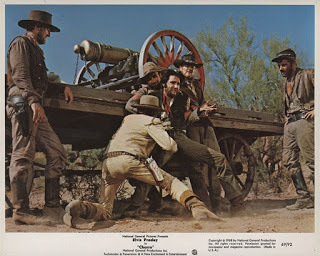 The conflict at the heart of Charro! revolves around a gold-plated Mexican cannon belonging to Emperor Maximilian, which has been stolen by an outlaw band. The Mexican army, various Mexican thugs, and bounty hunter Jess Wade are after the $2,000 reward for the return of the cannon. As the story progresses, the outlaws want to ransom the cannon back to the town from where it was stolen. By this time they have trapped Wade into working with them as they use the cannon to terrorize the town into capitulation. Tension and violence soak Whittington’s take on the story, written with the lean muscular prose for which he was renown. CHARRO!—ELVIS
The conflict at the heart of Charro! revolves around a gold-plated Mexican cannon belonging to Emperor Maximilian, which has been stolen by an outlaw band. The Mexican army, various Mexican thugs, and bounty hunter Jess Wade are after the $2,000 reward for the return of the cannon. As the story progresses, the outlaws want to ransom the cannon back to the town from where it was stolen. By this time they have trapped Wade into working with them as they use the cannon to terrorize the town into capitulation. Tension and violence soak Whittington’s take on the story, written with the lean muscular prose for which he was renown. CHARRO!—ELVIS
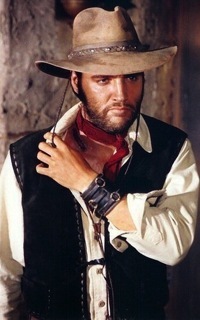 The lead role in the movie Charro! was supposed to be filled by Clint Eastwood, which will make perfect sense a paragraph or two from now. When Eastwood wisely made himself unavailable, Elvis—a fan of Westerns—jumped into the fire having only seen the same film treatment—filled with sex and violence—as Whittington used as the basis for his novelization. Elvis believed this was his big chance to break away from popcorn musicals and show his acting chops. Money was paid to the Colonel for Elvis’ services—allegedly $850,000, which was more than half the film’s budget. Contracts were signed. And then Elvis was handed the shooting script, which was a weak shadow of the treatment he had based his agreement to star...Unhappiness ensued, but Elvis was by then legally obligated to fulfill the role.
The lead role in the movie Charro! was supposed to be filled by Clint Eastwood, which will make perfect sense a paragraph or two from now. When Eastwood wisely made himself unavailable, Elvis—a fan of Westerns—jumped into the fire having only seen the same film treatment—filled with sex and violence—as Whittington used as the basis for his novelization. Elvis believed this was his big chance to break away from popcorn musicals and show his acting chops. Money was paid to the Colonel for Elvis’ services—allegedly $850,000, which was more than half the film’s budget. Contracts were signed. And then Elvis was handed the shooting script, which was a weak shadow of the treatment he had based his agreement to star...Unhappiness ensued, but Elvis was by then legally obligated to fulfill the role.
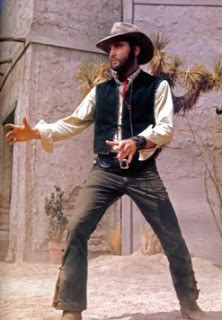 On the positive side, this would still be a movie where he wouldn’t break into a hit-bound ditty at the drop of a guitar. He would however record the theme (Charro) to be played over the credits, and one other song (Memories), which was not used in the film. He grew a scrubby beard for the movie, but felt so self-conscious everyone on the set (including Colonel Tom Parker his ownself) grew beards to support him. The film was a modest hit, but was not well received by Elvis’ legions of fans who didn’t want to accept him in movies which didn’t feature him crooning a half-dozen songs on screen. Perhaps if Charro! had been written to resurrect the Gene Autry/Tex Ritter singing cowboy genre, it would have fit Elvis’ image better.
On the positive side, this would still be a movie where he wouldn’t break into a hit-bound ditty at the drop of a guitar. He would however record the theme (Charro) to be played over the credits, and one other song (Memories), which was not used in the film. He grew a scrubby beard for the movie, but felt so self-conscious everyone on the set (including Colonel Tom Parker his ownself) grew beards to support him. The film was a modest hit, but was not well received by Elvis’ legions of fans who didn’t want to accept him in movies which didn’t feature him crooning a half-dozen songs on screen. Perhaps if Charro! had been written to resurrect the Gene Autry/Tex Ritter singing cowboy genre, it would have fit Elvis’ image better.
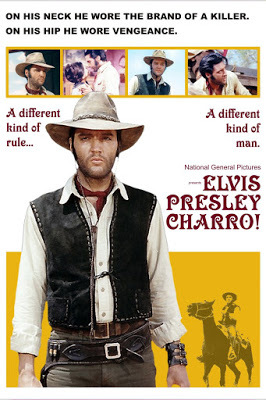 CHARRO!—THE MOVIE As a film Charro! is a mess—a meta mash-up of tail chasing styles. Originally, it was green lighted for production on the understanding it was to be Hollywood’s stylized spin on the mega-popular Spaghetti Westerns of Sergio Leone and the Euro Westerns of other Italian and Spanish directors. This was the meta tail chasing part, since Spaghetti and Euro Westerns were already foreign spins on the original Hollywood oaters. Based on his laconic Spaghetti Western stardom in films like The Good, The Bad, And The Ugly, it’s easy to see why Clint Eastwood would have been conceived as perfect for the lead role. Whatever his reasons for passing on the movie, Eastwood’s choice was far better for his career than trying to stop a trainwreck with his presence. The effort to capture the lightening of a standard Hollywood oater, seen through the six-gun kaleidoscope of European-style gratuitous sex and violence on horseback in foreign locations posing as the wild west, then translating it all back into a new Hollywood Western only stylized like a foreign version of a Hollywood Western, but with all the gratuitous sex and violence removed, proved too much for director Charles Marquis Warren. Better known for his television work on Gunsmoke and other early TV series westerns, Warren struggled when trying to direct for the big screen western. The idea of what Charro! was intended to be was clearly too much for him to grasp, and Warren retreated behind the safety of his television experience. It would be his final outing of his undistinguished career as a movie director. Take the run on sentence from a couple of paragraphs above, describing the intent of the film and associated challenges, then dump it into a bucket of made-for-TV movie molasses, and you have Charro!—a zebrapottomus crossed with a lamaphant raised by a pig-in-a-poke. Can you say schizophrenic hybrid disaster? I knew you could...
CHARRO!—THE MOVIE As a film Charro! is a mess—a meta mash-up of tail chasing styles. Originally, it was green lighted for production on the understanding it was to be Hollywood’s stylized spin on the mega-popular Spaghetti Westerns of Sergio Leone and the Euro Westerns of other Italian and Spanish directors. This was the meta tail chasing part, since Spaghetti and Euro Westerns were already foreign spins on the original Hollywood oaters. Based on his laconic Spaghetti Western stardom in films like The Good, The Bad, And The Ugly, it’s easy to see why Clint Eastwood would have been conceived as perfect for the lead role. Whatever his reasons for passing on the movie, Eastwood’s choice was far better for his career than trying to stop a trainwreck with his presence. The effort to capture the lightening of a standard Hollywood oater, seen through the six-gun kaleidoscope of European-style gratuitous sex and violence on horseback in foreign locations posing as the wild west, then translating it all back into a new Hollywood Western only stylized like a foreign version of a Hollywood Western, but with all the gratuitous sex and violence removed, proved too much for director Charles Marquis Warren. Better known for his television work on Gunsmoke and other early TV series westerns, Warren struggled when trying to direct for the big screen western. The idea of what Charro! was intended to be was clearly too much for him to grasp, and Warren retreated behind the safety of his television experience. It would be his final outing of his undistinguished career as a movie director. Take the run on sentence from a couple of paragraphs above, describing the intent of the film and associated challenges, then dump it into a bucket of made-for-TV movie molasses, and you have Charro!—a zebrapottomus crossed with a lamaphant raised by a pig-in-a-poke. Can you say schizophrenic hybrid disaster? I knew you could...
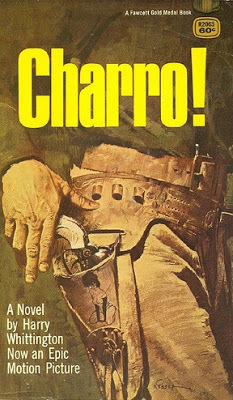 CHARRO!—THE COVER Now your brain hurts, it’s time to return circuitously to the subject of novelizations and particularly the cover for the paperback novelization of Charro! Charro! isn’t only an outstanding novel—the Gold Medal first edition has an awesome cover by Ron Lesser. Known for his iconic posters for Clint Eastwood films, Lesser illustrated covers for hundreds of paperback westerns, mass market softcovers, and movie posters. What makes this particular cover exceptional is the addition of the illustrated the dancehall girl on the holster. The first time I saw the cover, I thought the dancehall girl was an aftermarket doodle. But it is an example of Lesser’s gift of artistic genius—He gleaned the detail of the dancehall girl on the holster from the novel then added it as a unique touch.
CHARRO!—THE COVER Now your brain hurts, it’s time to return circuitously to the subject of novelizations and particularly the cover for the paperback novelization of Charro! Charro! isn’t only an outstanding novel—the Gold Medal first edition has an awesome cover by Ron Lesser. Known for his iconic posters for Clint Eastwood films, Lesser illustrated covers for hundreds of paperback westerns, mass market softcovers, and movie posters. What makes this particular cover exceptional is the addition of the illustrated the dancehall girl on the holster. The first time I saw the cover, I thought the dancehall girl was an aftermarket doodle. But it is an example of Lesser’s gift of artistic genius—He gleaned the detail of the dancehall girl on the holster from the novel then added it as a unique touch.
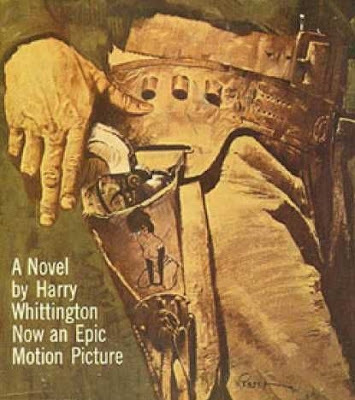 Interestingly, the cover blurb calls the book a novel, not a novelization—a subtle, but deceptive difference. Whittington’s name is on the front. However, in parenthesis under Whittington’s name, the title page makes reference to the book being based on a story by Frederick Louis Fox. This type of treatment was unusual for a novelization—presenting it as if the movie was based on the book instead of the other way around.
Interestingly, the cover blurb calls the book a novel, not a novelization—a subtle, but deceptive difference. Whittington’s name is on the front. However, in parenthesis under Whittington’s name, the title page makes reference to the book being based on a story by Frederick Louis Fox. This type of treatment was unusual for a novelization—presenting it as if the movie was based on the book instead of the other way around.
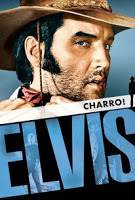 There is also another related oddity…Charro! is the novelization of an Elvis Presley movie. This should have been considered a huge marketing bonus. But if so, why is there no tie-in photo of Elvis in his role as Charro on the cover? Why is there no mention of it being an Elvis movie—not even on the back cover? Inquiring minds want to know.
There is also another related oddity…Charro! is the novelization of an Elvis Presley movie. This should have been considered a huge marketing bonus. But if so, why is there no tie-in photo of Elvis in his role as Charro on the cover? Why is there no mention of it being an Elvis movie—not even on the back cover? Inquiring minds want to know.
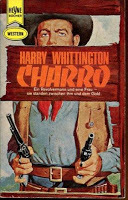 Perhaps there were contractual issues at the time regarding the use of Elvis’ image. Maybe there was a dispute between the publisher and the movie studio over the novelization. Or possibly the book was so much better than the final shooting script, it became an embarrassment to the director/screenwriter of the movie.
Perhaps there were contractual issues at the time regarding the use of Elvis’ image. Maybe there was a dispute between the publisher and the movie studio over the novelization. Or possibly the book was so much better than the final shooting script, it became an embarrassment to the director/screenwriter of the movie.
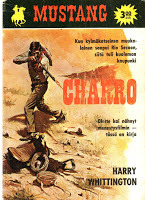 There is also a chance the situation ensued because Whittington put the original sex and violence from the treatment back into the novelization. This, as stated, didn’t mesh with the director’s puritanical standards, which had caused them to be removed from the shooting script in the first place. Whatever the reason, Charro!may be a less than inspired movie. It is, however, an inspired example of a genre Western, a novelization, Harry Whittington’s writing chops, and the type of cover painting I’d love to have hanging on my wall. This rabbit hole still has several off-shoots, but they are best left unexplored. There are plenty of other rabbit holes waiting for me to fall down.
There is also a chance the situation ensued because Whittington put the original sex and violence from the treatment back into the novelization. This, as stated, didn’t mesh with the director’s puritanical standards, which had caused them to be removed from the shooting script in the first place. Whatever the reason, Charro!may be a less than inspired movie. It is, however, an inspired example of a genre Western, a novelization, Harry Whittington’s writing chops, and the type of cover painting I’d love to have hanging on my wall. This rabbit hole still has several off-shoots, but they are best left unexplored. There are plenty of other rabbit holes waiting for me to fall down.
Published on May 29, 2017 15:40
May 23, 2017
HOLMES, WATSON, AND SALMON—PART TWO
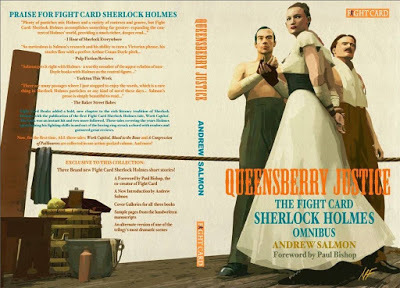 HOLMES, WATSON, AND SALMON—PART TWO— Last week, Andrew Salmon shared with us his anecdotes and thoughts on writing the Fight Card Sherlock Holmes books and the current collection of his Holmes stories, Queensberry Justice: A Fight Card Sherlock Holmes Omnibus. This week he shares more about one of the most important original characters in his Fight Card Sherlock Holmes stories—Eby Stokes. ******** Eby Stokes is become an important character in the second and third Fight Card Sherlock Holmes tales. How did the character come to be?
HOLMES, WATSON, AND SALMON—PART TWO— Last week, Andrew Salmon shared with us his anecdotes and thoughts on writing the Fight Card Sherlock Holmes books and the current collection of his Holmes stories, Queensberry Justice: A Fight Card Sherlock Holmes Omnibus. This week he shares more about one of the most important original characters in his Fight Card Sherlock Holmes stories—Eby Stokes. ******** Eby Stokes is become an important character in the second and third Fight Card Sherlock Holmes tales. How did the character come to be?
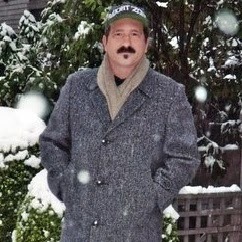 I thought the best way to get Holmes involved in women's boxing was to have him doing a favor for a female fighter whose boxer husband has run out on her under mysterious circumstances. She was originally named Liv Stokes in honor of Elizabeth Stokes, the winner of the first recorded woman's bare knuckle boxing match in 1722. And I was approaching her introduction into the tale when real life tragedy struck. You based the appearance and illustrated version of Eby Stokes on a particular person. Can you tell us who and why?
I thought the best way to get Holmes involved in women's boxing was to have him doing a favor for a female fighter whose boxer husband has run out on her under mysterious circumstances. She was originally named Liv Stokes in honor of Elizabeth Stokes, the winner of the first recorded woman's bare knuckle boxing match in 1722. And I was approaching her introduction into the tale when real life tragedy struck. You based the appearance and illustrated version of Eby Stokes on a particular person. Can you tell us who and why?
 A dear friend of my wife's and myself died suddenly. Her name was Linda Gavin and she was like a sister to my wife. Linda was intelligent, compassionate and everyone who knew her thought the world of her. Her sudden passing hit many people very hard. My wife and myself included. Dealing with our grief while attempting to make some progress on the tale, I hit on the idea of honoring Linda's memory by renaming my female boxer. Linda was a staunch advocate for gender equality and a tough, capable, intelligent boxer who could go toe to toe with Holmes was a character she would have appreciated. Thus Liv Stokes became Eby Stokes—Eby being Linda's maiden name. As the book was to be released a few months after Linda's memorial, I dedicated the book to her memory, but also asked artist Mike Fyles if he could shape his depiction of Eby on the cover to match some photos of a young Linda I sent him. Mike's great and agreed immediately.
A dear friend of my wife's and myself died suddenly. Her name was Linda Gavin and she was like a sister to my wife. Linda was intelligent, compassionate and everyone who knew her thought the world of her. Her sudden passing hit many people very hard. My wife and myself included. Dealing with our grief while attempting to make some progress on the tale, I hit on the idea of honoring Linda's memory by renaming my female boxer. Linda was a staunch advocate for gender equality and a tough, capable, intelligent boxer who could go toe to toe with Holmes was a character she would have appreciated. Thus Liv Stokes became Eby Stokes—Eby being Linda's maiden name. As the book was to be released a few months after Linda's memorial, I dedicated the book to her memory, but also asked artist Mike Fyles if he could shape his depiction of Eby on the cover to match some photos of a young Linda I sent him. Mike's great and agreed immediately.
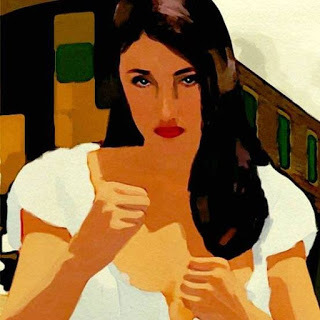 Where things got spooky was with his depiction. I sent him an image of Linda in her youth (boxing is a young person's game) and Eby Stokes needed to be a young woman. Mike used the photo as his model, but unlike the old photo, Mike placed Eby's hair pulled down in front of her left shoulder. What's spooky about that? Well, in later life, Linda always placed her hair in the same spot before a photo. She would go out of her way to do so. It was something of a joke when posing for photographs—hold on, wait for Linda to arrange her hair. So how did Mike know about her hair? I never told him. The photo didn't show it. And yet there it was. This was yet another indication the character of Eby Stokes was taking on a life all her own. This had been evident to me while writing Blood to the Bone as she matched wits with Holmes and Watson and demonstrated her fighting prowess. To see Mike channel Linda into Eby's appearance with no prompting from anyone who knew her was a wonderful moment. The reaction readers have had to her in her first two appearances continue the real life affect Linda had on people. They were drawn to her, felt comfortable with her, and she was always ready to help when and where she could. She has infused the character of Eby Stokes, and I think this has gone a long way to explaining her instant popularity. What was your vision for Queensberry Justice: The Fight Card Sherlock Holmes Omnibus?
Where things got spooky was with his depiction. I sent him an image of Linda in her youth (boxing is a young person's game) and Eby Stokes needed to be a young woman. Mike used the photo as his model, but unlike the old photo, Mike placed Eby's hair pulled down in front of her left shoulder. What's spooky about that? Well, in later life, Linda always placed her hair in the same spot before a photo. She would go out of her way to do so. It was something of a joke when posing for photographs—hold on, wait for Linda to arrange her hair. So how did Mike know about her hair? I never told him. The photo didn't show it. And yet there it was. This was yet another indication the character of Eby Stokes was taking on a life all her own. This had been evident to me while writing Blood to the Bone as she matched wits with Holmes and Watson and demonstrated her fighting prowess. To see Mike channel Linda into Eby's appearance with no prompting from anyone who knew her was a wonderful moment. The reaction readers have had to her in her first two appearances continue the real life affect Linda had on people. They were drawn to her, felt comfortable with her, and she was always ready to help when and where she could. She has infused the character of Eby Stokes, and I think this has gone a long way to explaining her instant popularity. What was your vision for Queensberry Justice: The Fight Card Sherlock Holmes Omnibus?
 Anyone reading this who owns a copy of the omnibus—you have my vision of the book. I think it came out great! When you first proposed the idea of the omnibus, I was flattered and humbled at the idea of collecting the material in a deluxe format. Discussing the cover art with the brilliant Mike Fyles, I merely asked for something iconic. Not for my own ego, but rather, for the concept, which was completely and utterly original. Getting to be the first at something is a high honor and I'm proud of all the work the team did on the three books. So why not put the omnibus out there as a testament? But to Mike. I just said, go iconic and left it in his more than capable hands. Well, you see the result! He comes back with this incredible wraparound cover! Of course we had to make the inside live up to the cover! I think we did. We've got your great foreword, I threw in an introduction, the books and essays themselves, the brand new short stories, the cover and art galleries—I mean, wow! What more can one ask for? We've given the reader not only a nice collection of the original books, but have also invited him or her behind the curtain at Fight Card Central. A truly immersive experience. There are a number of related articles in the omnibus. What is their theme and purpose?
Anyone reading this who owns a copy of the omnibus—you have my vision of the book. I think it came out great! When you first proposed the idea of the omnibus, I was flattered and humbled at the idea of collecting the material in a deluxe format. Discussing the cover art with the brilliant Mike Fyles, I merely asked for something iconic. Not for my own ego, but rather, for the concept, which was completely and utterly original. Getting to be the first at something is a high honor and I'm proud of all the work the team did on the three books. So why not put the omnibus out there as a testament? But to Mike. I just said, go iconic and left it in his more than capable hands. Well, you see the result! He comes back with this incredible wraparound cover! Of course we had to make the inside live up to the cover! I think we did. We've got your great foreword, I threw in an introduction, the books and essays themselves, the brand new short stories, the cover and art galleries—I mean, wow! What more can one ask for? We've given the reader not only a nice collection of the original books, but have also invited him or her behind the curtain at Fight Card Central. A truly immersive experience. There are a number of related articles in the omnibus. What is their theme and purpose?
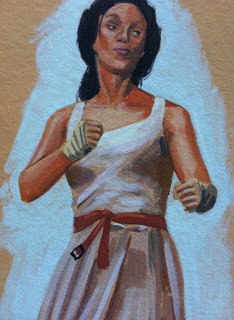 The articles were great fun to do. The idea was, again, that glimpse behind the curtain at how we got the books done. But also, they allowed for some of the history to be explored. Not just the fictional history concerning how Doyle planted the seeds for Fight Card Sherlock Holmes in the original canon but also the real history of the fight game at that time. I do know that the revelation of Victorian women's bare knuckle boxing caused a mini-explosion when we showcased it in the second book, Blood to the Bone. More than one reader and reviewer thought I had made that up out of whole cloth - a modern retcon of history - and were blown away when the essays accompanying the book revealed women's bare knuckle boxing to be fact, not fiction! I believe this is one of the major achievements of the series outside of just reading enjoyment. And I hope the forgotten history of these tough, capable women will continue to grow through the Fight Card Books and journalistic pursuits. You worked closely with illustrator Mike Fyles on the covers of the second and third Fight Card Sherlock Holmes novels and the omnibus. Can you tell us about that collaboration?
The articles were great fun to do. The idea was, again, that glimpse behind the curtain at how we got the books done. But also, they allowed for some of the history to be explored. Not just the fictional history concerning how Doyle planted the seeds for Fight Card Sherlock Holmes in the original canon but also the real history of the fight game at that time. I do know that the revelation of Victorian women's bare knuckle boxing caused a mini-explosion when we showcased it in the second book, Blood to the Bone. More than one reader and reviewer thought I had made that up out of whole cloth - a modern retcon of history - and were blown away when the essays accompanying the book revealed women's bare knuckle boxing to be fact, not fiction! I believe this is one of the major achievements of the series outside of just reading enjoyment. And I hope the forgotten history of these tough, capable women will continue to grow through the Fight Card Books and journalistic pursuits. You worked closely with illustrator Mike Fyles on the covers of the second and third Fight Card Sherlock Holmes novels and the omnibus. Can you tell us about that collaboration?
 Mike Fyles is the best artist in New Pulp. Period. And that's saying something because there are a number of very good artists at work today. Seeing his great work over the years, I used to yearn for a Fyles cover the way the great writers of the 60s yearned for a Robert McGinnis cover. I approached him for a project many years ago, a project I felt was going to be truly special and needed the best in the business to frame it. Then I just crossed my fingers and prayed. He replied favorably and I could breathe again. It was while working on that project (which will be finished soon) that Mike and I just clicked. I would give him as much information on a subject as I could and he would create stunning images which encapsulated all of my hopes for a character or scene. Bringing him in to the Fight Card team for the debut of Eby Stokes in Blood to the Bonejust felt right. He's gone on to breathe life into her and Holmes ever since. I work with these characters on the page, painting word pictures, but he adds so much detail, soul and makes them unforgettable once his work is viewed in conjunction with the tales themselves. It's a natural collaboration, we just click, and the results have blown me away. He's great! And I'm honored to work with him. As a side note, my depiction of Dr. Moore Agar is based on Mike. What can I say? He looks like Dr. Agar! Mike and I have many projects ahead of us.
Mike Fyles is the best artist in New Pulp. Period. And that's saying something because there are a number of very good artists at work today. Seeing his great work over the years, I used to yearn for a Fyles cover the way the great writers of the 60s yearned for a Robert McGinnis cover. I approached him for a project many years ago, a project I felt was going to be truly special and needed the best in the business to frame it. Then I just crossed my fingers and prayed. He replied favorably and I could breathe again. It was while working on that project (which will be finished soon) that Mike and I just clicked. I would give him as much information on a subject as I could and he would create stunning images which encapsulated all of my hopes for a character or scene. Bringing him in to the Fight Card team for the debut of Eby Stokes in Blood to the Bonejust felt right. He's gone on to breathe life into her and Holmes ever since. I work with these characters on the page, painting word pictures, but he adds so much detail, soul and makes them unforgettable once his work is viewed in conjunction with the tales themselves. It's a natural collaboration, we just click, and the results have blown me away. He's great! And I'm honored to work with him. As a side note, my depiction of Dr. Moore Agar is based on Mike. What can I say? He looks like Dr. Agar! Mike and I have many projects ahead of us.
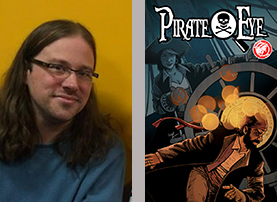 While discussing artists, we shouldn't leave out Carl Yonder who provided the great cover for Work Capitol, the first Fight Card Sherlock Holmes book. I don't know Carl well personally, but I am very familiar with his distinctive work on Pirate Eye and elsewhere. He brought a great feel and tone to the Work Capitolcover. Carl, like me, had to create something completely new and original. We were all in uncharted territory. And he did a great job. It was such a treat to include the cover and art galleries in the omnibus. The collection was meant to be a captivating showcase for what Fight Card Books achieved and the work of Carl and Mike was crucial to any success the individual books received. The omnibus just wouldn't be complete without them stepping out to take their bows.
While discussing artists, we shouldn't leave out Carl Yonder who provided the great cover for Work Capitol, the first Fight Card Sherlock Holmes book. I don't know Carl well personally, but I am very familiar with his distinctive work on Pirate Eye and elsewhere. He brought a great feel and tone to the Work Capitolcover. Carl, like me, had to create something completely new and original. We were all in uncharted territory. And he did a great job. It was such a treat to include the cover and art galleries in the omnibus. The collection was meant to be a captivating showcase for what Fight Card Books achieved and the work of Carl and Mike was crucial to any success the individual books received. The omnibus just wouldn't be complete without them stepping out to take their bows.
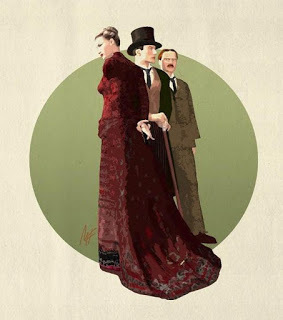 You wrote three Sherlock Holmes short stories exclusive to Queensberry Justice. Are they connected to the Fight Card Sherlock Holmes novels? By the time we were putting together the omnibus, I was well underway creating the world of Eby Stokes and her important connection to the three Fight Card books. I liked this idea of connectivity and thought it would be fun to connect the three books more so than just having them connected under one cover. This also provided an opportunity to re-visit the Fight Card Sherlock Holmes world one more time. The result was three new short stories sprinkled strategically through the omnibus. The first kicks off the omnibus and expands on the training Holmes received before we encounter him in Work Capitol. The second is for Eby Stokes fans. It is set before she teams up with Holmes and Watson in Blood to the Bone, and has some connection to the goings on in Work Capitol. The third story features Watson in a solo outing and delves deeper into his mindset before the start of ACongression of Pallbearers. Hopefully readers will get the feeling they are reading one long narrative as they work through the omnibus.
You wrote three Sherlock Holmes short stories exclusive to Queensberry Justice. Are they connected to the Fight Card Sherlock Holmes novels? By the time we were putting together the omnibus, I was well underway creating the world of Eby Stokes and her important connection to the three Fight Card books. I liked this idea of connectivity and thought it would be fun to connect the three books more so than just having them connected under one cover. This also provided an opportunity to re-visit the Fight Card Sherlock Holmes world one more time. The result was three new short stories sprinkled strategically through the omnibus. The first kicks off the omnibus and expands on the training Holmes received before we encounter him in Work Capitol. The second is for Eby Stokes fans. It is set before she teams up with Holmes and Watson in Blood to the Bone, and has some connection to the goings on in Work Capitol. The third story features Watson in a solo outing and delves deeper into his mindset before the start of ACongression of Pallbearers. Hopefully readers will get the feeling they are reading one long narrative as they work through the omnibus.
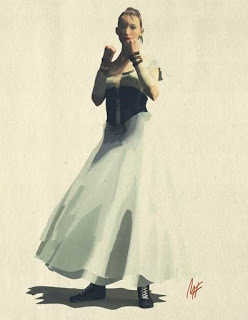 While Sherlock may be taking a respite from his fistic pursuits, what is in store for Eby Stokes? To illustrate how dense I could be, as I came to the end of writing A Congression of Pallbearers, the third and final book in the omnibus, I found myself being saddened at the thought of saying goodbye to some of the characters we'd encountered over the course of the trilogy. I had already decided after the second book and the impact Eby Stokes made on readers to spin her off into her own series. Plus I knew I would continue writing Holmes tales. But for some of the other characters, this was goodbye.
While Sherlock may be taking a respite from his fistic pursuits, what is in store for Eby Stokes? To illustrate how dense I could be, as I came to the end of writing A Congression of Pallbearers, the third and final book in the omnibus, I found myself being saddened at the thought of saying goodbye to some of the characters we'd encountered over the course of the trilogy. I had already decided after the second book and the impact Eby Stokes made on readers to spin her off into her own series. Plus I knew I would continue writing Holmes tales. But for some of the other characters, this was goodbye.
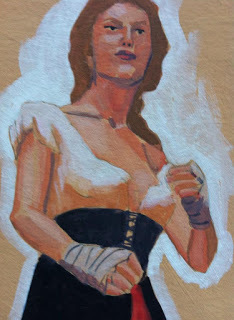 The closer I got to the end of writing the book, my mind began to muse on the Eby Stokes series and how I'd be faced with filling out her supporting cast and setting up her world until, duh, I realized, why not use the characters I was so reluctant to say goodbye to in the original trilogy in the new series? And so, the Eby Stokes series will be a direct off-shoot of the Fight Card books. Queensberry Justiceserves, in a way, as the origin story for Eby Stokes. In her first novel, which I will hopefully have out later this year, she'll be presented fully formed and getting down to the Crown's business. Normally so much time has to be put in at the outset to fill in the protagonist's back story, but here the three Fight Card books collected in the omnibus do that on a much broader canvas, making it, in a way, Book One of the Eby Stokes series as well as a fun collection of Holmes tales. I've got ideas for the first four novels in the Eby Stokes series. I hope readers will enjoy getting closer to Eby. Learning more about her has been fun for the author. I hope it's as much fun for readers. She is one capable individual.
The closer I got to the end of writing the book, my mind began to muse on the Eby Stokes series and how I'd be faced with filling out her supporting cast and setting up her world until, duh, I realized, why not use the characters I was so reluctant to say goodbye to in the original trilogy in the new series? And so, the Eby Stokes series will be a direct off-shoot of the Fight Card books. Queensberry Justiceserves, in a way, as the origin story for Eby Stokes. In her first novel, which I will hopefully have out later this year, she'll be presented fully formed and getting down to the Crown's business. Normally so much time has to be put in at the outset to fill in the protagonist's back story, but here the three Fight Card books collected in the omnibus do that on a much broader canvas, making it, in a way, Book One of the Eby Stokes series as well as a fun collection of Holmes tales. I've got ideas for the first four novels in the Eby Stokes series. I hope readers will enjoy getting closer to Eby. Learning more about her has been fun for the author. I hope it's as much fun for readers. She is one capable individual.
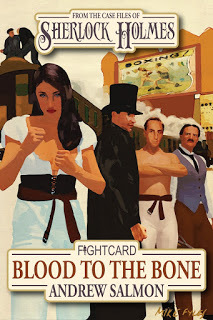 Here's an exclusive tease of the first novel in progress: Eby Stokes is working under Mycroft Holmes at Special Branch, heading up a team of action agents consisting of herself, Dr. Moore Agar (the personal physician of Sherlock Holmes) and Peter Hayden, a dwarf of considerable abilities from Work Capitol. London is overrun with spies, anarchists, and dynamite provocateurs and there's a plot brewing with catastrophic consequences not just for England but the world. What has creating the Fight Card Sherlock Holmes novels and the critical acclaim they have received meant to you as a writer?
Here's an exclusive tease of the first novel in progress: Eby Stokes is working under Mycroft Holmes at Special Branch, heading up a team of action agents consisting of herself, Dr. Moore Agar (the personal physician of Sherlock Holmes) and Peter Hayden, a dwarf of considerable abilities from Work Capitol. London is overrun with spies, anarchists, and dynamite provocateurs and there's a plot brewing with catastrophic consequences not just for England but the world. What has creating the Fight Card Sherlock Holmes novels and the critical acclaim they have received meant to you as a writer?
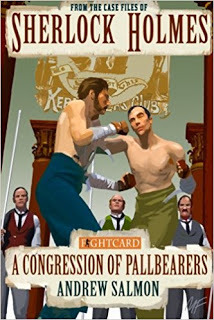 I've been fortunate to work with some great folks! Ron Fortier and Rob Davis at Airship 27, Tommy Hancock at Pro Se Press, and of course, a certain Mr. Bishop over at Fight Card Books. All of these experiences have been different, but also rewarding. My Holmes tales for Airship 27 were a hit with Sherlockians and mystery fans alike. The two awards my work have garnered, for which I'm eternally grateful, were for Sherlock Holmes tales. When the invitation to create something utterly new in Holmes history was suggested to me, I was so honored to be considered for the task. Suddenly the pressure to get it right was on my shoulders. Also, there was nowhere for me to hide so to speak. All of my Holmes tales had been part of anthologies with other writers. Now, it was just me handling the writing duties. With the rich legacy of Doyle's Sherlock Holmes, I had to step up, center stage, and Get. It. Right. The pressure was on, and I welcomed the work.
I've been fortunate to work with some great folks! Ron Fortier and Rob Davis at Airship 27, Tommy Hancock at Pro Se Press, and of course, a certain Mr. Bishop over at Fight Card Books. All of these experiences have been different, but also rewarding. My Holmes tales for Airship 27 were a hit with Sherlockians and mystery fans alike. The two awards my work have garnered, for which I'm eternally grateful, were for Sherlock Holmes tales. When the invitation to create something utterly new in Holmes history was suggested to me, I was so honored to be considered for the task. Suddenly the pressure to get it right was on my shoulders. Also, there was nowhere for me to hide so to speak. All of my Holmes tales had been part of anthologies with other writers. Now, it was just me handling the writing duties. With the rich legacy of Doyle's Sherlock Holmes, I had to step up, center stage, and Get. It. Right. The pressure was on, and I welcomed the work.
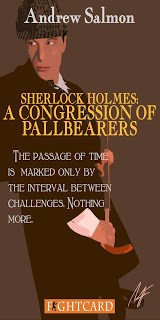
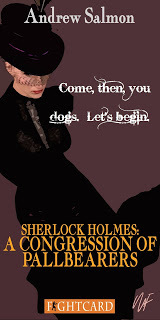
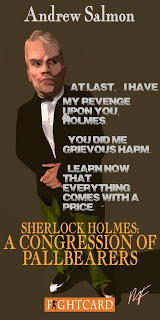
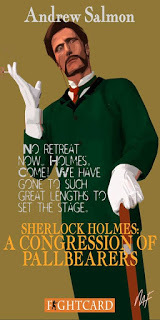 Seeing the positive reactions to the individual books and, already, strong reaction to the omnibus, has been a wonderful stepping out for me into the Sherlockian world. The vast army of dedicated Holmes fans are a true test of a writer's abilities. If one can write Holmes and Watson to a level which satisfies these passionate fans, then one knows he or she is on the right track. A writer cannot judge their work. Readers decide if a work is a success or not. The positive reaction has been heart-warming and encouraging for me, and I thank everyone who has given these tales a try. I wrote these tales for readers, and readers have enjoyed them. Mission accomplished. And now I want to continue the same pattern with the Eby Stokes series, more Holmes tales eventually, and other projects. The reaction to Fight Card Sherlock Holmes has shown me there are readers eager to come along for the ride. That's a responsibility I take very seriously and am so grateful for it. I can promise readers they will always get my absolute best effort every time. Hold on tight, it's going to be a wild ride!******** A tip of the non-canonical deerstalker to Andrew as he exits the interrogation room to hail a hansom cab and heads back to meet Eby Stokes on the foggy streets of Victorian London...
Seeing the positive reactions to the individual books and, already, strong reaction to the omnibus, has been a wonderful stepping out for me into the Sherlockian world. The vast army of dedicated Holmes fans are a true test of a writer's abilities. If one can write Holmes and Watson to a level which satisfies these passionate fans, then one knows he or she is on the right track. A writer cannot judge their work. Readers decide if a work is a success or not. The positive reaction has been heart-warming and encouraging for me, and I thank everyone who has given these tales a try. I wrote these tales for readers, and readers have enjoyed them. Mission accomplished. And now I want to continue the same pattern with the Eby Stokes series, more Holmes tales eventually, and other projects. The reaction to Fight Card Sherlock Holmes has shown me there are readers eager to come along for the ride. That's a responsibility I take very seriously and am so grateful for it. I can promise readers they will always get my absolute best effort every time. Hold on tight, it's going to be a wild ride!******** A tip of the non-canonical deerstalker to Andrew as he exits the interrogation room to hail a hansom cab and heads back to meet Eby Stokes on the foggy streets of Victorian London...
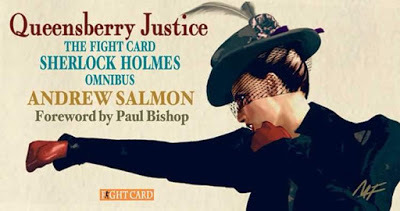
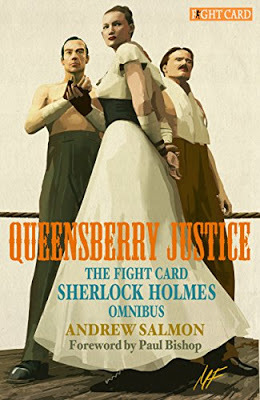 QUEENSBERRY JUSTICE THE FIGHT CARD SHERLOCK HOLMES OMNIBUS Fight Card Booksadded a bold, new chapter to the rich literary tradition of Sherlock Holmes with the publication of the first Fight Card Sherlock Holmes tale, Work Capitol. The book was an instant hit and two more followed. These tales covering the years Holmes spent honing his fighting skills in and out of the boxing ring struck a chord with readers and garnered great reviews. Now, for the first time, ALL three tales: Work Capitol, Blood to the Bone and A Congression of Pallbearers are collected in one action-packed volume. And more! EXCLUSIVE TO THIS COLLECTION Three Brand new Fight Card Sherlock Holmes short stories Foreword by Paul Bishop, the co-creator of Fight Card New Introduction by Andrew Salmon Cover Galleries for all 3 books Sample pages from the handwritten manuscripts An alternate version of one of the trilogy's most dramatic scenes
QUEENSBERRY JUSTICE THE FIGHT CARD SHERLOCK HOLMES OMNIBUS Fight Card Booksadded a bold, new chapter to the rich literary tradition of Sherlock Holmes with the publication of the first Fight Card Sherlock Holmes tale, Work Capitol. The book was an instant hit and two more followed. These tales covering the years Holmes spent honing his fighting skills in and out of the boxing ring struck a chord with readers and garnered great reviews. Now, for the first time, ALL three tales: Work Capitol, Blood to the Bone and A Congression of Pallbearers are collected in one action-packed volume. And more! EXCLUSIVE TO THIS COLLECTION Three Brand new Fight Card Sherlock Holmes short stories Foreword by Paul Bishop, the co-creator of Fight Card New Introduction by Andrew Salmon Cover Galleries for all 3 books Sample pages from the handwritten manuscripts An alternate version of one of the trilogy's most dramatic scenes
Published on May 23, 2017 18:01
HOLMES, WATSON, AND SALMON—PART ONE
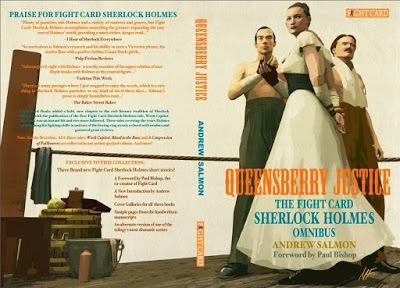 HOLMES, WATSON, AND SALMON—PART ONE— As the creator and editor of the Fight Card series, I was delighted by the notion of a Fight Card Sherlock Holmes tale. I was even more delighted as I knew exactly who I wanted to write such a tale. I was familiar with a number of Andrew Salmon’s Sherlock Holmes pastiches in the Sherlock Holmes Consulting Detectiveseries from
Airship 27
, and admired the way he was able to capture the tone and linguistic rhythm of Doyle’s original stories. Fortunately, Andrew was also familiar with the style and content of the Fight Card books, having reviewed a number of the series entries. When I put the idea to Andrew his response was instantaneous and positive. He was captured by the concept and wasted no time getting started on the research for what would become the first Fight Card Sherlock Holmes tale, Work Capital (a Victorian term for the death sentence), which was published in December 2013. Fight Card Sherlock Holmes: Work Capitol met with universal praise from both Fight Card fans and Sherlockians. What could be more natural than for Andrew to begin work on a new tale of Victorian pugilism. Fight Card Sherlock Holmes: Blood To The Bone would be more than the second fistic outing for Holmes. It also gave birth to Eby Stokes, a female pugilist to rival The Woman in her effect on Holmes and Watson—and on readers. Blood To The Bone saw publication in December of 2014, establishing a Fight Card Sherlock Holmesfor Christmas tradition. The character of Eby Stokes grabbed hold of Andrew and me and wouldn’t let us go. I insisted Andrew had to write a third Fight Card Sherlock Holmes entry, and Eby Stokes had to be part of it. Fight Card Sherlock Holmes: A Congression Of Pallbearers brought a major change into the career of Eby Stokes as she joins Holmes and Watson to once again protect the sovereignty.
HOLMES, WATSON, AND SALMON—PART ONE— As the creator and editor of the Fight Card series, I was delighted by the notion of a Fight Card Sherlock Holmes tale. I was even more delighted as I knew exactly who I wanted to write such a tale. I was familiar with a number of Andrew Salmon’s Sherlock Holmes pastiches in the Sherlock Holmes Consulting Detectiveseries from
Airship 27
, and admired the way he was able to capture the tone and linguistic rhythm of Doyle’s original stories. Fortunately, Andrew was also familiar with the style and content of the Fight Card books, having reviewed a number of the series entries. When I put the idea to Andrew his response was instantaneous and positive. He was captured by the concept and wasted no time getting started on the research for what would become the first Fight Card Sherlock Holmes tale, Work Capital (a Victorian term for the death sentence), which was published in December 2013. Fight Card Sherlock Holmes: Work Capitol met with universal praise from both Fight Card fans and Sherlockians. What could be more natural than for Andrew to begin work on a new tale of Victorian pugilism. Fight Card Sherlock Holmes: Blood To The Bone would be more than the second fistic outing for Holmes. It also gave birth to Eby Stokes, a female pugilist to rival The Woman in her effect on Holmes and Watson—and on readers. Blood To The Bone saw publication in December of 2014, establishing a Fight Card Sherlock Holmesfor Christmas tradition. The character of Eby Stokes grabbed hold of Andrew and me and wouldn’t let us go. I insisted Andrew had to write a third Fight Card Sherlock Holmes entry, and Eby Stokes had to be part of it. Fight Card Sherlock Holmes: A Congression Of Pallbearers brought a major change into the career of Eby Stokes as she joins Holmes and Watson to once again protect the sovereignty.
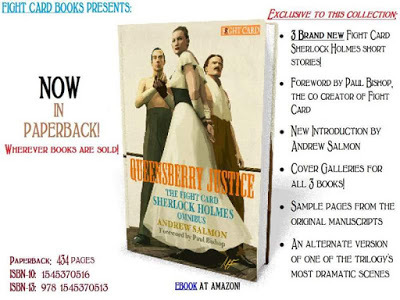 With the publication of Queensberry Justice: The Fight Card Sherlock Holmes Omnibus, Andrew brings together not only his three Fight Card Sherlock Holmesnovels, but a plethora of original related articles, three new Fight Card Sherlock Holmes short stories, a cover gallery, and much more. Beautifully produced and chock full of great Sherlockian stories and other ephemera, Queensberry Justice is a fitting culmination to the current iteration of the Fight Card series. I was honored to have been part of the process of organizing, editing, and producing this fantastic piece of Sherlockiana. Featuring a stunning wraparound cover from artist Mike Fyles, Queensberry Justice is everything we envisioned it would be. With Queensberry Justice: The Fight Card Sherlock Holmes Omnibus now available, Andrew has time to be hit with the bright lights of the interrogation room and tell us about the journey.******** What would Scotland Yard’s Victorian Ledger Of Miscreants tell us about Andrew Salmon?
With the publication of Queensberry Justice: The Fight Card Sherlock Holmes Omnibus, Andrew brings together not only his three Fight Card Sherlock Holmesnovels, but a plethora of original related articles, three new Fight Card Sherlock Holmes short stories, a cover gallery, and much more. Beautifully produced and chock full of great Sherlockian stories and other ephemera, Queensberry Justice is a fitting culmination to the current iteration of the Fight Card series. I was honored to have been part of the process of organizing, editing, and producing this fantastic piece of Sherlockiana. Featuring a stunning wraparound cover from artist Mike Fyles, Queensberry Justice is everything we envisioned it would be. With Queensberry Justice: The Fight Card Sherlock Holmes Omnibus now available, Andrew has time to be hit with the bright lights of the interrogation room and tell us about the journey.******** What would Scotland Yard’s Victorian Ledger Of Miscreants tell us about Andrew Salmon?
 The record would show he was born in Montreal, Canada. He eventually corrected that mistake and moved with his wife to Vancouver, Canada, with the goal of becoming a writer. It would further show he is an omnivorous reader and consumer of pop culture goings on. A dedicated pulp fan, he has been churning out pulp tales as well as Sherlock Holmes yarns for many a year. He's published, or been part of, 30 books to date with many more to come. His work has been nominated for a handful of awards and even won a pair. He is also a dedicated film extra who has appeared in movies such as Watchmen, Fantastic Four, and in TV shows like Fringe, Arrow, The Flash, Timeless, Supernatural, and many others. When did you first read a Sherlock Holmes story, and were you hooked right away? Holmes was very patient with me. I first encountered The Sign of Four in a college class on Detective Fiction. Honestly, I didn't think much of it. This would have been around 1984 or '85. Holmes waited until 2008 to weave his spell. Asked to contribute a tale for Airship 27's first Holmes anthology, I initially said no reluctantly because as you can see, I hadn't put the work in with regards to the dynamic duo of Holmes and Watson. Getting on board, I dove into the canon and was immediately struck by the quality of the tales and the characters. Took a while but Holmes hooked me in the end. Do you have a favorite Sherlock Holmes story? The Empty Houseand The Three Garridebs are my two favorite Holmes stories. I don't think one can compare one plot to another so I don't use that basis. These two tales, however, have my two favorite Holmes and Watson moments. Seeing Watson's reaction to Holmes suddenly coming back from the dead is great fun and very poignant in The Empty House. Holmes is not one to easily express his emotions and his readiness to murder the man who shot Watson displays the depth of his feelings for his friend. I keep these two moments in mind whenever I write a Holmes/Watson conversation or interaction. Do you consider yourself a Sherlockian? Not in the truest sense of the term. Am I a huge fan? No question. But exploring all things Sherlockian, for me, is enjoyed as I plot out a new tale. Holmes is not a hobby for me, he's my job. I guess he's getting me back for those years I ignored him. Ha! Have you read many Sherlock tales outside of the original canon?
The record would show he was born in Montreal, Canada. He eventually corrected that mistake and moved with his wife to Vancouver, Canada, with the goal of becoming a writer. It would further show he is an omnivorous reader and consumer of pop culture goings on. A dedicated pulp fan, he has been churning out pulp tales as well as Sherlock Holmes yarns for many a year. He's published, or been part of, 30 books to date with many more to come. His work has been nominated for a handful of awards and even won a pair. He is also a dedicated film extra who has appeared in movies such as Watchmen, Fantastic Four, and in TV shows like Fringe, Arrow, The Flash, Timeless, Supernatural, and many others. When did you first read a Sherlock Holmes story, and were you hooked right away? Holmes was very patient with me. I first encountered The Sign of Four in a college class on Detective Fiction. Honestly, I didn't think much of it. This would have been around 1984 or '85. Holmes waited until 2008 to weave his spell. Asked to contribute a tale for Airship 27's first Holmes anthology, I initially said no reluctantly because as you can see, I hadn't put the work in with regards to the dynamic duo of Holmes and Watson. Getting on board, I dove into the canon and was immediately struck by the quality of the tales and the characters. Took a while but Holmes hooked me in the end. Do you have a favorite Sherlock Holmes story? The Empty Houseand The Three Garridebs are my two favorite Holmes stories. I don't think one can compare one plot to another so I don't use that basis. These two tales, however, have my two favorite Holmes and Watson moments. Seeing Watson's reaction to Holmes suddenly coming back from the dead is great fun and very poignant in The Empty House. Holmes is not one to easily express his emotions and his readiness to murder the man who shot Watson displays the depth of his feelings for his friend. I keep these two moments in mind whenever I write a Holmes/Watson conversation or interaction. Do you consider yourself a Sherlockian? Not in the truest sense of the term. Am I a huge fan? No question. But exploring all things Sherlockian, for me, is enjoyed as I plot out a new tale. Holmes is not a hobby for me, he's my job. I guess he's getting me back for those years I ignored him. Ha! Have you read many Sherlock tales outside of the original canon? 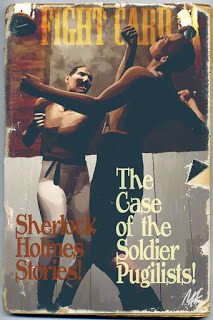 Unfortunately I can't. While researching a tale for an upcoming anthology with a different take on the characters, I hit the local library for some pastiches with a similar theme. Some of the tales I encountered did not use Watson as narrator and that just doesn't work for me. For this fan, the tale must be told by Watson. Others used Watson, but poorly. Some did a great job. Over the course of reading a few of them, I reached back for my Watson voice—and it was gone! It had become diluted by the other Watsons, both good and bad. This was a scary moment let me tell you. I've had to avoid pastiches ever since, I'm sorry to say. When the day comes I hang up my deerstalker, I'll have mountains of material to read. Do you have a favorite pastiche? I don't have a particular favorite for reason outlined in the last question. That said, I've sampled enough of I. A. Watson's (how appropriate is his name?) work and he channels Watson beautifully. His stories are great fun! Aaron Smith also does some great work. Were you a fan of the Basil Rathbone films? I did enjoy the films but not as much as some. Any bumbling Watson will turn me off the material. Rathbone was great as Holmes however. They nailed his part of it. Jeremy Brett, Benedict Cumberbatch, Johnny Lee Miller, or Robert Downey Jr.?
Unfortunately I can't. While researching a tale for an upcoming anthology with a different take on the characters, I hit the local library for some pastiches with a similar theme. Some of the tales I encountered did not use Watson as narrator and that just doesn't work for me. For this fan, the tale must be told by Watson. Others used Watson, but poorly. Some did a great job. Over the course of reading a few of them, I reached back for my Watson voice—and it was gone! It had become diluted by the other Watsons, both good and bad. This was a scary moment let me tell you. I've had to avoid pastiches ever since, I'm sorry to say. When the day comes I hang up my deerstalker, I'll have mountains of material to read. Do you have a favorite pastiche? I don't have a particular favorite for reason outlined in the last question. That said, I've sampled enough of I. A. Watson's (how appropriate is his name?) work and he channels Watson beautifully. His stories are great fun! Aaron Smith also does some great work. Were you a fan of the Basil Rathbone films? I did enjoy the films but not as much as some. Any bumbling Watson will turn me off the material. Rathbone was great as Holmes however. They nailed his part of it. Jeremy Brett, Benedict Cumberbatch, Johnny Lee Miller, or Robert Downey Jr.?
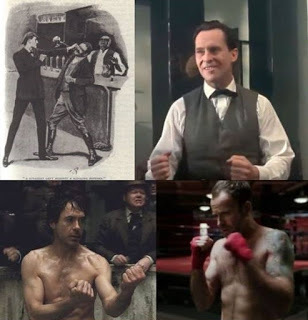 My Holmes and Watson dream team consists of Jeremy Brett and Jude Law. For me, these are the best Holmes and Watson we've seen to date. I do like Cumberbatch's interpretation, although the show has strayed too far from the source for this fan. Downey Jr., I really enjoy a lot although they have lost the character's fastidiousness and play him as a shabby eccentric rather than a neat one. I haven't seen enough of Johnny Lee to render an opinion. The idea of a female Watson just doesn't work for me. Of the duo, Watson is my favorite—I like him just the way Doyle gave him to us—so such a radical change in presentation is not for me. I should, and will, check out some clips of Johnny Lee in action just to see what he brings to the character. How did you start writing Sherlock Holmes pastiches?
My Holmes and Watson dream team consists of Jeremy Brett and Jude Law. For me, these are the best Holmes and Watson we've seen to date. I do like Cumberbatch's interpretation, although the show has strayed too far from the source for this fan. Downey Jr., I really enjoy a lot although they have lost the character's fastidiousness and play him as a shabby eccentric rather than a neat one. I haven't seen enough of Johnny Lee to render an opinion. The idea of a female Watson just doesn't work for me. Of the duo, Watson is my favorite—I like him just the way Doyle gave him to us—so such a radical change in presentation is not for me. I should, and will, check out some clips of Johnny Lee in action just to see what he brings to the character. How did you start writing Sherlock Holmes pastiches?
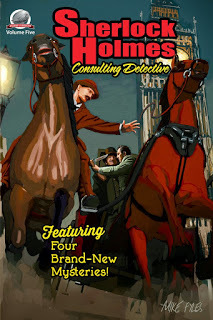 When pulp publisher, Airship 27, was putting together their first Sherlock Holmes anthology, I was asked to contribute as I had worked closely with them and they were familiar with my work and myself. I originally said no because I had not read the canon at that point and felt I was not qualified to honor the original material. It was only after much thought I realized I couldn't pass up a chance to write the two most popular characters in fiction. So I dove into the canon and have been having a great time ever since. Had you written Holmes stories prior to those commissioned for the Airship 27 Sherlock Holmes Consulting Detectiveseries?
When pulp publisher, Airship 27, was putting together their first Sherlock Holmes anthology, I was asked to contribute as I had worked closely with them and they were familiar with my work and myself. I originally said no because I had not read the canon at that point and felt I was not qualified to honor the original material. It was only after much thought I realized I couldn't pass up a chance to write the two most popular characters in fiction. So I dove into the canon and have been having a great time ever since. Had you written Holmes stories prior to those commissioned for the Airship 27 Sherlock Holmes Consulting Detectiveseries?
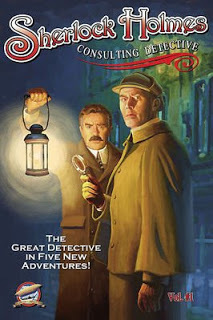 Not a one. Never even thought about writing one. So imagine my surprise when my first attempt, "The Adventure of the Locked Room", won a Best Short Story Award at the inaugural New Pulp Awards presentation as well as extremely positive reviews from Sherlockians and mystery fans alike! I've been off and running ever since. What is important to you when writing a Holmes story? First, nailing Watson's voice. Second, nailing the characters. It's not easy to capture the feel and tone of the original tales and you've got to be careful. I came to it a little ahead of the game because of my lifelong love for Victorian literature. Dickens, for me, is the greatest writer in the English language. I've read everything of his I can get my hands on, including the mountain of his press work, which I'm still gobbling up. I'm also a big Dostoyevsky fan along with Tolstoy, Hardy, Thackeray, Conrad and others. I've been reading them constantly most of my life. I think this helped me absorb Doyle's approach. After much study, the voice came rather easily to me. Plotting tales, setting clues about, getting to know the characters—these were the real challenges and it's also great fun!
Not a one. Never even thought about writing one. So imagine my surprise when my first attempt, "The Adventure of the Locked Room", won a Best Short Story Award at the inaugural New Pulp Awards presentation as well as extremely positive reviews from Sherlockians and mystery fans alike! I've been off and running ever since. What is important to you when writing a Holmes story? First, nailing Watson's voice. Second, nailing the characters. It's not easy to capture the feel and tone of the original tales and you've got to be careful. I came to it a little ahead of the game because of my lifelong love for Victorian literature. Dickens, for me, is the greatest writer in the English language. I've read everything of his I can get my hands on, including the mountain of his press work, which I'm still gobbling up. I'm also a big Dostoyevsky fan along with Tolstoy, Hardy, Thackeray, Conrad and others. I've been reading them constantly most of my life. I think this helped me absorb Doyle's approach. After much study, the voice came rather easily to me. Plotting tales, setting clues about, getting to know the characters—these were the real challenges and it's also great fun!
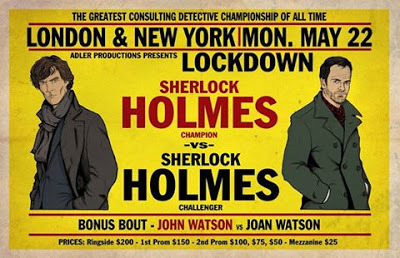 I've written other public domain characters over the years. My approach is always that of the ghost writers during the Golden Age of Pulp Fiction. They would step in for Walter Gibson or Lester Dent and write a tale with the idea it could slip into the canon of The Shadow or Doc Savage and no one would notice. I like this way of doing things because, in the end, it's not about the writer, it's about the beloved characters. What Doyle created is incredible and enduring. Who am I, or any Holmes scribe, to come in and mess with it? I've heard from readers and reviewers who have said they didn't feel they were reading pastiche when they read the Fight Card Sherlock Holmes books, they felt as if they were reading Doyle. That takes my breath away! There is no higher honor readers can bestow on a writer of Holmes tales. One reader told me Work Capitol was his favorite Holmes story and he included the canon in his assessment! Now, I don't believe these statements for a minute, but they do my heart good. If people are reading Queensberry Justice a century from now, I might settle a little more comfortably in my grave. But the fact they believe it is truly humbling. It means we've succeeded in what we set out to do. And it inspires me to keep trying to get better.
I've written other public domain characters over the years. My approach is always that of the ghost writers during the Golden Age of Pulp Fiction. They would step in for Walter Gibson or Lester Dent and write a tale with the idea it could slip into the canon of The Shadow or Doc Savage and no one would notice. I like this way of doing things because, in the end, it's not about the writer, it's about the beloved characters. What Doyle created is incredible and enduring. Who am I, or any Holmes scribe, to come in and mess with it? I've heard from readers and reviewers who have said they didn't feel they were reading pastiche when they read the Fight Card Sherlock Holmes books, they felt as if they were reading Doyle. That takes my breath away! There is no higher honor readers can bestow on a writer of Holmes tales. One reader told me Work Capitol was his favorite Holmes story and he included the canon in his assessment! Now, I don't believe these statements for a minute, but they do my heart good. If people are reading Queensberry Justice a century from now, I might settle a little more comfortably in my grave. But the fact they believe it is truly humbling. It means we've succeeded in what we set out to do. And it inspires me to keep trying to get better.
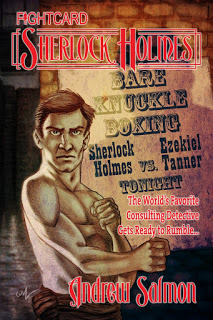 What was your first response to the idea of a Fight Card Sherlock Holmes novel? In the space of a nano-second, it went something like this, I'll do it! Wait, how the hell am I going to do it? Having wanted to be part of the Fight Card lineup since I first stumbled upon it, this was a dream come true. Plus this concept, as far as I've been able to determine, was a first for Sherlock Holmes. No small feat given the long, rich history of the character. Sure, the first Downey Jr. movie gave us Holmes in a fighting pit, but the plot was not about Victorian bare knuckle boxing. This concept was! Exciting stuff! What did you determine about Holmes as a boxer in order to make his character work in the context of a Fight Card novel? It would have to be a melding of mind and body. The first Downey film showed us, really, the onlyway Holmes would behave in a fighting pit or boxing ring. He's all about study and bringing the information to a conclusion. And this is how he'd operate in the ring—study his opponent, test his strength and abilities, plan a strategy to counteract and overcome them. Execute. So this is the approach I used because, as I said, there is no other way Holmes would do it. He'd never be a mindless bruiser throwing fists chaotically around and he'd certainly never be out-thought in the ring. An opponent would get punches in of course—experience always counts for something—but his opponent wouldn't land the same punch twice.
What was your first response to the idea of a Fight Card Sherlock Holmes novel? In the space of a nano-second, it went something like this, I'll do it! Wait, how the hell am I going to do it? Having wanted to be part of the Fight Card lineup since I first stumbled upon it, this was a dream come true. Plus this concept, as far as I've been able to determine, was a first for Sherlock Holmes. No small feat given the long, rich history of the character. Sure, the first Downey Jr. movie gave us Holmes in a fighting pit, but the plot was not about Victorian bare knuckle boxing. This concept was! Exciting stuff! What did you determine about Holmes as a boxer in order to make his character work in the context of a Fight Card novel? It would have to be a melding of mind and body. The first Downey film showed us, really, the onlyway Holmes would behave in a fighting pit or boxing ring. He's all about study and bringing the information to a conclusion. And this is how he'd operate in the ring—study his opponent, test his strength and abilities, plan a strategy to counteract and overcome them. Execute. So this is the approach I used because, as I said, there is no other way Holmes would do it. He'd never be a mindless bruiser throwing fists chaotically around and he'd certainly never be out-thought in the ring. An opponent would get punches in of course—experience always counts for something—but his opponent wouldn't land the same punch twice.
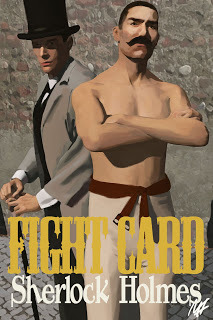 From this and Holmes's lack of experience in the beginning, I saw Holmes as a brilliant counter-puncher. Through study, Holmes could get past his opponent's guard when he was partially exposed in throwing a punch and would know precisely which area to strike at depending on his opponent's body position. Sure, this is Fighting 101, but Holmes could also predict a blow, by studying body language (as seen in the Downey film), before it came and could counter an instant earlier so the counter blow would pack a full wallop. This study of his opponent would also give Holmes uncanny evasion abilities. These I borrowed from Muhammad Ali who could stand toe to toe with his opponent and not a punch would land—he'd even completely drop his guard to fake out the other fighter. The quick, intuitive mind of Holmes, in tune with his natural athletic ability, allows him to evade like Ali. I explained this technique in the first of the three new Sherlock Holmes tales in the omnibus. Also, as bare knuckle boxing at the time allowed for throws and grappling, the time Holmes put in studying Baritsu would come into play when needed. Ultimately, Holmes was the first MMA artist in fiction and this gives him a distinct advantage when the Queensberry Rules go out the window. To sum up—Holmes is a dangerous man. What was the research process like for the Fight Card Sherlock Holmes stories? Very intensive and time consuming. And I loved every minute of it. I'm a research madman! I can't get enough of it. No detail is too small. I had to research the state of boxing in Victorian times from a standpoint of fight techniques, the language of the ring (via newspapers accounts of fights), the rules concerning fighting and the ring dimensions, training practices, diet, etc. From there, I had to interpret all of the above through Watson's eye as narrator as I put together what Holmes knew about pugilistic technique and how he applied it. The same went for women's boxing after I stumbled upon that nugget of forgotten history. Great fun! Did the plots for the stories grow out of the research or did you have the plots and then research the details? I always love to pull plot details right out of the historical record. Stitching together real history into a fictional tapestry makes for fun reading, I think. Learning while being entertained results in knowledge staying in the memory. The first bout of research uncovered the Victorian women's boxing information, and I filed it away for Blood to the Bone. It also uncovered the Kernoozer's Club, which I tucked away for A Congression of Pallbearers. Finding training manuals and newspapers accounts of fights helped me set the scene for Work Capitol, and learning how retired fighters almost always went on to run taverns helped with getting my characters in place. The real fun is when little nuggets of history begin to stitch themselves together into plots. I love burrowing into the past to see what jumps out at me. ********
From this and Holmes's lack of experience in the beginning, I saw Holmes as a brilliant counter-puncher. Through study, Holmes could get past his opponent's guard when he was partially exposed in throwing a punch and would know precisely which area to strike at depending on his opponent's body position. Sure, this is Fighting 101, but Holmes could also predict a blow, by studying body language (as seen in the Downey film), before it came and could counter an instant earlier so the counter blow would pack a full wallop. This study of his opponent would also give Holmes uncanny evasion abilities. These I borrowed from Muhammad Ali who could stand toe to toe with his opponent and not a punch would land—he'd even completely drop his guard to fake out the other fighter. The quick, intuitive mind of Holmes, in tune with his natural athletic ability, allows him to evade like Ali. I explained this technique in the first of the three new Sherlock Holmes tales in the omnibus. Also, as bare knuckle boxing at the time allowed for throws and grappling, the time Holmes put in studying Baritsu would come into play when needed. Ultimately, Holmes was the first MMA artist in fiction and this gives him a distinct advantage when the Queensberry Rules go out the window. To sum up—Holmes is a dangerous man. What was the research process like for the Fight Card Sherlock Holmes stories? Very intensive and time consuming. And I loved every minute of it. I'm a research madman! I can't get enough of it. No detail is too small. I had to research the state of boxing in Victorian times from a standpoint of fight techniques, the language of the ring (via newspapers accounts of fights), the rules concerning fighting and the ring dimensions, training practices, diet, etc. From there, I had to interpret all of the above through Watson's eye as narrator as I put together what Holmes knew about pugilistic technique and how he applied it. The same went for women's boxing after I stumbled upon that nugget of forgotten history. Great fun! Did the plots for the stories grow out of the research or did you have the plots and then research the details? I always love to pull plot details right out of the historical record. Stitching together real history into a fictional tapestry makes for fun reading, I think. Learning while being entertained results in knowledge staying in the memory. The first bout of research uncovered the Victorian women's boxing information, and I filed it away for Blood to the Bone. It also uncovered the Kernoozer's Club, which I tucked away for A Congression of Pallbearers. Finding training manuals and newspapers accounts of fights helped me set the scene for Work Capitol, and learning how retired fighters almost always went on to run taverns helped with getting my characters in place. The real fun is when little nuggets of history begin to stitch themselves together into plots. I love burrowing into the past to see what jumps out at me. ********
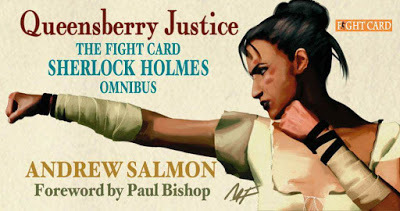 NEXT WEEK—MORE FROM ANDREW SALMON AND THE ADVENTURES OF HOLMES AND WATSON IN THE PUGILISTIC WORLD OF VICTORIAN ENGLAND…
NEXT WEEK—MORE FROM ANDREW SALMON AND THE ADVENTURES OF HOLMES AND WATSON IN THE PUGILISTIC WORLD OF VICTORIAN ENGLAND…
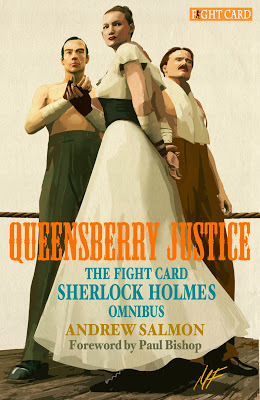 QUEENSBERRY JUSTICETHE FIGHT CARD SHERLOCK HOLMES OMNIBUS Fight Card Booksadded a bold, new chapter to the rich literary tradition of Sherlock Holmes with the publication of the first Fight Card Sherlock Holmes tale, Work Capitol. The book was an instant hit and two more followed. These tales covering the years Holmes spent honing his fighting skills in and out of the boxing ring struck a chord with readers and garnered great reviews. Now, for the first time, ALL three tales: Work Capitol, Blood to the Bone and A Congression of Pallbearers are collected in one action-packed volume. And more! EXCLUSIVE TO THIS COLLECTION Three Brand new Fight Card Sherlock Holmes short storiesForeword by Paul Bishop, the co-creator of Fight CardNew Introduction by Andrew SalmonCover Galleries for all 3 booksSample pages from the handwritten manuscriptsAn alternate version of one of the trilogy's most dramatic scenes
QUEENSBERRY JUSTICETHE FIGHT CARD SHERLOCK HOLMES OMNIBUS Fight Card Booksadded a bold, new chapter to the rich literary tradition of Sherlock Holmes with the publication of the first Fight Card Sherlock Holmes tale, Work Capitol. The book was an instant hit and two more followed. These tales covering the years Holmes spent honing his fighting skills in and out of the boxing ring struck a chord with readers and garnered great reviews. Now, for the first time, ALL three tales: Work Capitol, Blood to the Bone and A Congression of Pallbearers are collected in one action-packed volume. And more! EXCLUSIVE TO THIS COLLECTION Three Brand new Fight Card Sherlock Holmes short storiesForeword by Paul Bishop, the co-creator of Fight CardNew Introduction by Andrew SalmonCover Galleries for all 3 booksSample pages from the handwritten manuscriptsAn alternate version of one of the trilogy's most dramatic scenes
Published on May 23, 2017 17:29



